US use in the Pacific Theater of Operations
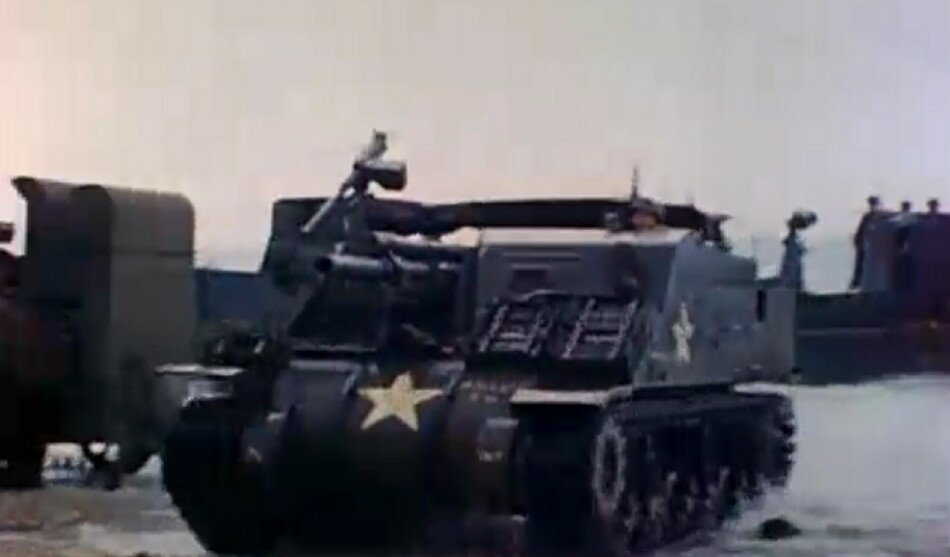
A number of the regimental cannon companies of the 20 US Army infantry divisions deployed to the Pacific Theater of Operations were organized under a modified table of organization and equipment "TO&E 7-14S" published in February 1944. This authorized the companies to be equipped with "105-mm Howitzer, Self-Propelled." This would have replaced the July 1943 TO&E of "six 105-mm howitzers M3 with prime movers" with "six M7 HMCs with M10 armored ammunition trailers." Exactly when and which units were issued M7s has been hard to pinpoint, since not much is written about cannon companies in the Regimental AARs. This screen capture is part of some raw color footage strung together and cataloged as "BOMBARDMENT; AMPHIBIOUS OPERATIONS: SCENES AFTER OCCUPATION; INVASION OF ENIWETOX [sic]" on the National Archives website. The US Marine Corps history, "Central Pacific Drive", reports that on 18 February 1944, the 22nd Marine Regiment assaulted the island of Engebi in the Eniwetok Atoll. They were supported by "a platoon from the Cannon Company, 106th Infantry [Regiment, 27th US Army Infantry Division] with two 105-mm. self-propelled guns." Neither the USMC history or the official Army history ever refer to these as "M7s", but the definition of "105-mm. self-propelled gun" at this time would have been limited to the M7 and we do see a Priest in the film footage. In any case, at present, February 1944 is the earliest instance we have encountered of M7s in combat in the PTO. On Engebi, there is textual evidence that the M7s fought, "Near Skunk Point...1/22 encountered concrete pillboxes which were the key to the enemy defenses around the southeastern corner of the island. Two self-propelled 105mm guns from the 106th Infantry Cannon Company, weapons originally sent to the aid of Company A, were withdrawn upon request of Company C and sent to deal with the heavy fortifications. The self-propelled guns fired almost their entire day's allowance of ammunition, 80 rounds, in order to destroy two pillboxes, one of which sheltered 25 to 30 Japanese. Effective as they were, the self-propelled 105s were not especially popular with the infantry units which they supported. "They made a very inviting target for mortar and other small arms," commented a veteran of the Skunk Point fighting, "and, consequently, were not a very comforting thing to have around." The 105s, though, had revenge on their Japanese tormentors, for during the afternoon they wiped out an enemy mortar crew." Engebi was declared secured at 3 pm, 18 Feb. The 106th Infantry Regiment assaulted the next target, Eniwetok Island, on 19 February. There are several occasions in the Marine and Army histories when it is mentioned that "two Army self-propelled 105mm guns" supported elements of the 106th IR as well as the 3rd Battalion of the 22nd Marines. There are no mentions of the use of "self-propelled 105s" on Parry Island the final objective of the Eniwetok Atoll operation. We think that the screen capture shows an M7 landing on Eniwetok not Engebi, since the soldiers in the scene appear to be Army not Marines. The unit is shown debarking without wading trunk(s), although we suspect that the lower hull was sealed for shallow water fording. After watching the footage multiple times, we believe that there is a pintle mount for a 0.30 caliber machine gun (arrow) such as is seen in the photo in the next caption.
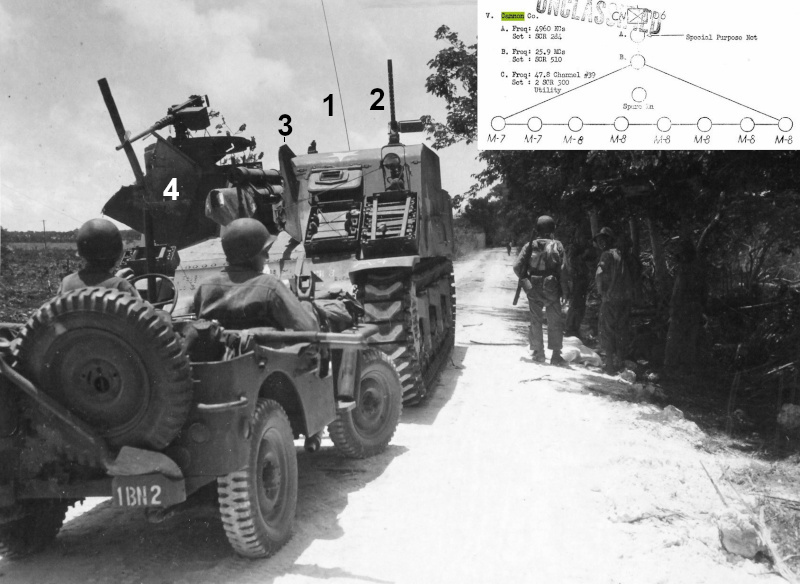
This Army Pictorial Service photograph is captioned, "Saipan. A self-propelled gun mount and a jeep stop beside American casualty after an unsuccessful attempt to storm Jap pillboxes." We take "6/20" typed on the caption to be the date, which would have to be 20 June 1944. On 15 June 1944, the 2nd and 4th USMC Divisions landed on Saipan's southwestern coast. Resistance was much fiercer than expected and the 20,000 man assault force suffered over 2,000 casualties in the first 24 hours. The 27th Infantry Division formed the reserve of the 5th Amphibious Corps and was ordered to land the 165th and the 105th Infantry Regiments on 16 and 17 June respectively. Elements of these units captured Aslito airfield on the 18th, and after that, their mission was to trap and "mop up" the enemy troops holed up around Nafutan Point in the island's southeast corner. It is thought that the photo shows part of this operation in which the 105th and 165th IRs attacked "heavily fortified built-in positions over exceedingly mountainous terrain." By a process of elimination, we would guess that the M7 was with the Cannon Company of the 165th IR, since the docs note that, at this time, the 105th was "without their organic cannon company, consisting of 75mm self-propelled guns [consequently] the regiment was incapable of suppressing the enemy while the infantry and engineers rooted them out." In the meantime, the 106th IR was still in floating reserve offshore. As noted in the previous caption, "a platoon from the Cannon Company, 106th Infantry with two 105-mm. self-propelled guns" supported Marine and Army units during the Eniwetok Operation. The records of the 106th IR for Saipan are a bit more helpful as they actually state that their Cannon Company consisted of 2 M7s and 6 M8 Howitzer Motor Carriages as shown in the radio diagram in the inset. We suspect that the 106th had this unusual arrangement during the Eniwetok Operation as well. It may have been based on the availability of M7s and M8s at the time. We might assume that the Cannon Companies of the 105th and 165th were similarly equipped but perhaps not, since it is mentioned that the cannon company of the 105th IR consisted of "75mm self-propelled guns." A comment in the 106th's files praises the performance of "the self-propelled mounts" and adds, "A truck drawn weapon as prescribed for the armament of the Cannon Company would have been unable to carry out the missions assigned." In any case, the M7 appears to have "CN 8" painted on the differential housing on the left side. It can be seen with an antenna (1) and a retrofitted .30 caliber machine gun (2). A pair of, shall we say, "flaps" (3 & 4), perhaps part of the waterproofing process, can be seen open on either side of the 105mm gun. The head lights are in the "high" position indicative of 1942/43 production M7s. The grouser boxes are in the "mod 1" configuration with the small plates with rounded corners welded on. We have looked but can't say that we have seen any 1944 production Priests in WW II "combat" photos in the PTO.
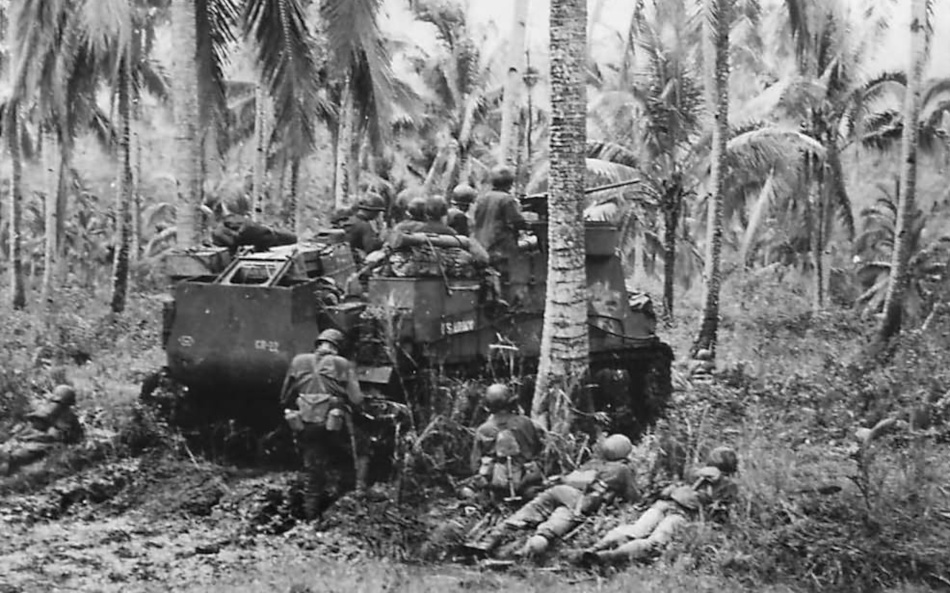
This Signal Corps photo is dated 29 October 1944 and captioned "Troops of the 381st Inf. Regt., 96th Div., take cover behind an M-7 tank while advancing on Catman [sic] Hill, Leyte Island, P.I.". The 96th Infantry Division landed alongside the 7th ID on Leyte near the town of Dulag on 20 October 1944. The 96th was responsible for expanding the northern sector of the beachhead which was dominated by Catmon Hill. The 381st and 383rd Infantry Regiments were involved in numerous assaults on the hill, while the 382nd IR bypassed the position to the west. Since the initial landings on the 20th, Catmon had been pounded for over a week by naval, air and land forces. It was finally taken on 28th October by enveloping attacks of the 1st and 2nd battalions of the 381st IR. The official US Army history states that the attack of the 1st Battalion was "supported by the massed fire of forty-five tanks and the Regimental Cannon Company." Perhaps to their relief, the assaulting units came to find that most of the Japanese troops had abandoned the hill two days earlier. It can be seen that the "shallow pulpit" M7 still has the lower section of a wading stack. It appears to have "CN 22" and some sort of symbol painted on the stack. Judging by the rounded bottom of the stack, it may have been from the M7 fording kit produced in the US. This looks to be another case where the gun travel lock was removed, and in this instance can be seen stored on top of the wading stack. The Leyte Campaign fulfilled General MacArthur's promise to return to the Philippines. After much hard fighting, the island was secured in early January 1945. The 96th ID along with other veteran divisions of Leyte next invaded Okinawa on 1 April 1945. The records of the 96th rarely mention the actions of the regimental cannon companies, although it was noted that the "self-propelled 105-mm. howitzer [was] extremely mobile in swamps and mountainous terrain. It was able to go several miles farther up the mountains than any other vehicles and gave excellent support in covering the mountain passes." The 96th fought in a number of key battles on Okinawa. In the final "Comments and Recommendations" section of their Operations Report, the Priests are at last named - "105mm Howitzer Motor Carriages, M-7" and numbered - 18, suggesting that there were 6 in each of the regimental cannon companies. Of interest is that 36 "76mm Gun Motor Carriages, M-18" are also listed as part of the division's "combat vehicular equipment." "Due to the addition of tank-like vehicles to the Inf Regts, it is... recommended that each Regt be authorized one Heavy Wrecker, M1A1", and that "An ordnance medium maintenance Co should replace the ordnance light maintenance Co now assigned to an Inf Div."
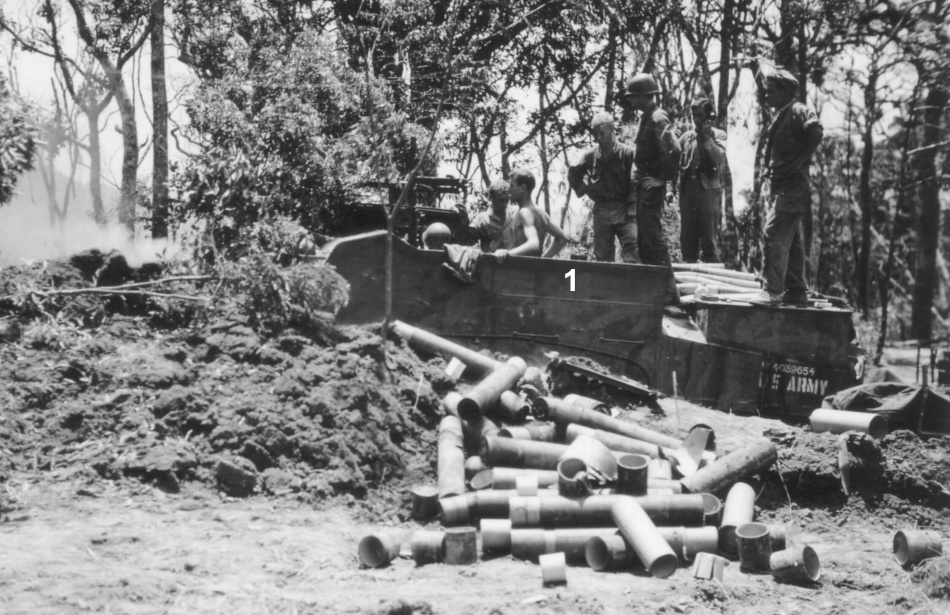
Cannon Companies are rarely mentioned in the unit records and histories of the Infantry Divisions that fought in the PTO, and when they are, their equipment is mostly described in very vague terms like "self-propelled guns." Maj. Wesley Curtis' 1950 Infantry School monograph provides some idea of the M7 timeline of the 27th Infantry Regiment, 25th Infantry Division. He was the recon officer of the Cannon Company of the 27th IR and he specifically states that the company "was organized under a modified table of equipment...[which] was the case with most of the regimental Cannon Companies in the Pacific area." On 28 January 1945, he reports that his cannon company was at full strength with 6 M7s with M10 trailers, and that the Priests had been issued to the regiment "some seven months prior to this operation." We interpret that to mean circa June 1944, which would have been while the unit was training in Noumea, New Caledonia. Curtis' monograph describes the Cannon Company's first combat with the M7s at Pemienta Luzon on 29-30 Jan. The gist is that the 1st Battalion, 27th IR set up a blocking position at a crossroads at Pemienta, which trapped a Japanese column of the 2nd Tank Division. At a range of 50 yards, Sgt. John Charney's M7 fired an armor piercing shell that destroyed an approaching enemy tank which blocked the road and halted the rest of the column. The 1st Battalion including at least 2 M7s attacked the column and repelled several Banzai charges from an enemy desperate to escape the trap. By daylight 30 January, 8 tanks, 8 10cm howitzers with prime movers, and a number of other enemy vehicles lay smoldering in the road. There is a Signal Corps photo of the wreckage, but not of the participating M7s as far as we know. The photo above is dated 8 April 1945 and captioned, "Men of the 25th Division in combat with Japs in Balete Pass, fire a U.S. M-7 from its dug-in position point-blank into a Jap pillbox 250 yards away." Beginning on 21 February, the 25th ID fought its way through the Caraballo Mountains and finally took the pivotal Balete Pass on 13 May. More grim fighting remained until the exhausted division was relieved on 30 June 1945 after "165 days of continuous combat." The M7 can be seen as USA 4039654 indicating July 1943 production. Most photos of M7s in the PTO show them installed with the US produced hinged armor plate modification, but this unit, along with a few others of the 25th seen in period photos, is noted with a field mod in which a plate (1) was neatly welded on. We count seven men in this photo, although in the course of his narrative, Major Curtis states, "Each M7 in addition to its normal 5 man crew carried a radio operator equipped with an SCR-300."
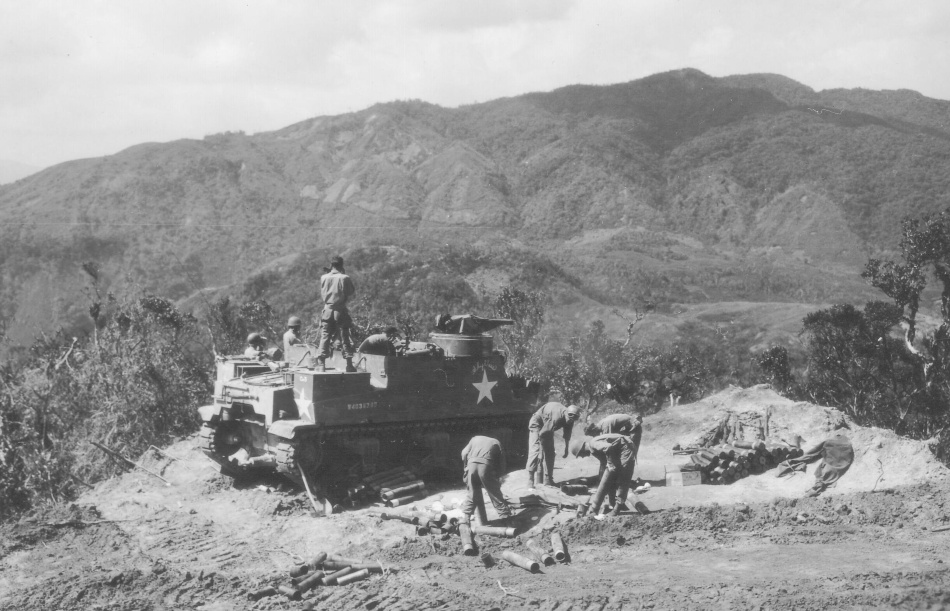
In a written account of his service, Sgt. Donald C. Boyd driver of #2 Section of Cannon Company, 128th Infantry Regiment, 32nd ID states that the unit received "6 new M7s" on Hollandia while training for the Leyte assault. The Priests replaced the 81mm mortars that the cannon company had used in previous campaigns. This would have been in the summer of 1944 after Hollandia had been captured and turned into a naval, air and logistics base in support of the liberation of the Philippines. The long serving veterans of the 32nd ID, who had completed operations on Leyte around New Year's 1945, arrived on Luzon on 27 January, eighteen days after the assault landings of the US Sixth Army at Lingayen Gulf. The division was immediately deployed by I Corps whose mission was "to expand the beachhead to the north and east, and protect the Lingayen base." By 2 February the 32nd had captured Santa Maria, the western terminus of the infamous Villa Verde Trail. US planners did not anticipate that the Japanese would defend the Caraballo mountains with such ferocity. It was expected that the 32nd would quickly break through the passes and link up with the 25th ID attacking north along Route 5. As it was, the "Red Arrow Division" fought itself to exhaustion in the 4 months it took to clear the enemy from the Villa Verde Trail. The photo is dated 12 April 1945 and captioned,"105mm self propelled howitzer of the 126th Cannon Co, firing on Jap positions on the Villa Verde Trail, Luzon, PI." At this time, the mission of the 126th IR was to attack and tie down the enemy positions on Yamashita Ridge (in the background of the photo), which flanked the trail, so that the 128th IR could take Salacsac Pass Number 2 without being subjected to harassing fire from the dominating heights. The Pass was finally secured on 16 April. In his account, Sgt. Boyd mentions that "The engineers had scraped out a firing position for us" which was probably similar to that seen in the photo. The Priest carries the name, "Shiftless" and appears to have "Cn 3" painted on the right-side stowage box. The M7's Registration Number can be read as USA 4038389 indicating December 1942 acceptance. From that we would assume that the "folding auxiliary armor plate" modification was retrofitted, possibly before the Priest was shipped from the US. Naturally, the division's vehicles would have been road bound in this type of environment, and the Villa Verde Trail at the time has been described as "a goat path in the clouds." The bulldozers of the 32nd ID's 114th Engineer Battalion became high priority targets of the Japanese defenders. Sgt. Boyd notes that while under fire, his M7 retrieved a bulldozer that had slid off the trail. To their great credit, the engineers did all they could to improve the trail to enable the movement of supply and combat vehicles, up to and including medium tanks, specifically, a platoon of Shermans of B Company, 775th Tank Battalion. One of their M4s, which appears to have been left in place after it burned, is on display at the Mangili Tindaan Historical Nature Park not far from the scene of our photo.

This Signal Corps photo is captioned, "Heavy Armor to the Pasig---U.S. tanks proceed along Sasmarinas [sic] street in Manila toward the Pasig River, where they will take up positions for the pounding of Jap positions south of the river." Using "Google Street View", Pierre-Olivier was able to determine that the photo was taken on the 200 block of Dasmarinas Street because the buildings on the right though damaged at the time, are still standing. The swift advance of the 1st Cavalry and the 37th Infantry Divisions caught the enemy off guard and spared a good deal of the northern sections of Manila the ruination suffered by the area south of the Pasig, which the Japanese turned into a fortified zone that they were determined to defend to the last man. We think that the M7s shown in the photo belonged to one of the cannon companies of the 37th ID, since the 1st Cav. Div. does not seem to have had had cannon companies until it was reorganized as an infantry division at the end of the war. The official caption of this photo is undated. However, the M18 Tank Destroyer in the background would lead us to think that it might have been taken on 17 February 1945 as the AAR of the 637th Tank Destroyer Bn reports "One section, 2d Platoon, Company C in support of the 2d Battalion 148th Infantry [fighting on the south side of the Pasig] placed 76mm fire on the SCIENCE and PHILIPPINE HOSPITAL BUILDINGS, opening large gaps in the walls so that 105mm High Explosive shells could be fired into the buildings with weapons of the Cannon Company." There is some SC footage in which the lead M7 in our photo is seen firing across the river and also shows that the Priest had a Donald Duck cartoon figure painted on the side (inset). The M7 and the Jeep in the photo can be seen with some sort of code "6429-S-20-22" that we have not been able to decipher. We might venture a guess that the M7s were part of the cannon company of the 148th Infantry Regiment, 37th ID which was engaged south of the river "in bitter hand assault combat [and] drove the enemy from the Science Building on the Southeast corner of Philippine General Hospital area by 1150 and secured the two Eastern wings of the main Hospital building by 1330." As a matter of minutia, we take this shallow pulpit M7 to be in the "grouser box mod 3" configuration where the original small grouser box was replaced with one that was somewhat larger, taller and notched. We will try to get some comparative measurements in the future, but for now, note that the 5-gallon jerrycan seen here, would not have been able to fit inside the original grouser box.
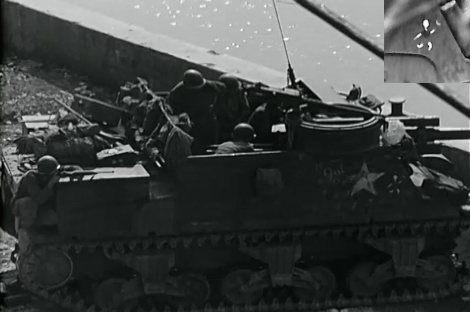
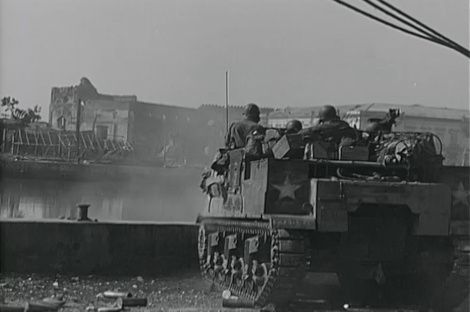
Here we have some more Signal Corps footage from the US National Archives website. In it, the photographer, whose name appears to have been "Gae Faillace", holds up an improvised clapperboard that shows "19 February" consistently throughout the footage. With the unusual surname, we believe the scenes must have been shot by Sgt. Gaetano Faillace, who is reported to have been "General Douglas MacArthur's personal photographer during World War II and the American occupation of Japan." Faillace took the well-known "I have returned" photo of MacArthur wading ashore at Leyte, 20 Oct 1944. However, it would appear that he was working with a movie camera on 19 February. In any case, by that time, most of the 37th ID and the 1st Cav were fighting on the south side of the Passig around the campus of the University of the Philippines. Some of the armor had crossed the river as well. We wanted to show a couple screen captures of an M7 that is featured in Faillace's footage about 5 minutes in. On the left is a side shot where the M7 is firing at targets across the river. This unit can be seen with the rear canvas cover frame installed with crew gear hanging from it. Also visible is a knapsack hanging off the right side of the M7. Based on that, we believe that this is the trailing Priest seen in the previous still photo. Note the little "stick figure" man painted in front of the star (inset). The "little man" has been observed on M7s in two SC still photos dated June 1945, one of which identifies the unit as the 145th Infantry Regiment, 37th ID, which suggests that these M7s were in the cannon company of the 145th IR. In the screen capture on the right, it can be seen that some plates (1), possibly hinged, have been added to protect the air cleaners. This field mod is noted in a few SC photos of M7s identified as with the 37th ID. The same "6429-S..." mystery code (2) appears to be painted on the left rear fender.
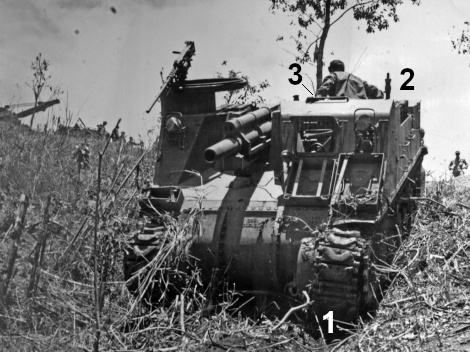
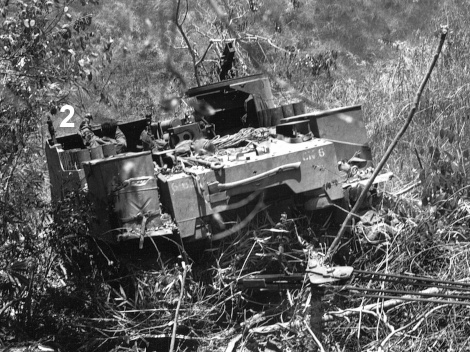
Here we have front and rear views of an M7 which, according to the caption, "plunged 150 yards down the side of a steep hill." No unit is given, but the tactical markings on the upper rear hull plate can be read as "6 63...CN 6" which we take to mean "6th Infantry Division, 63rd Infantry Regiment, Cannon Company #6." The photos are dated 24 April 1945, and the captions state that it "took 8 days and several methods" to retrieve the M7. From that we take it that this Priest was attempting to support the 63 IR during its final attacks on Mt. Mataba, a key objective on the formidable Shimbu Line, east of Manila. Mt. Mataba was finally taken by converging assaults of the 1st and 3rd Battalions, 63rd IR on 17 April. The souvenir history of the 6th ID notes that, "During the final assault, the infantry was supported by self-propelled mounts and tanks that were able to reach the area only by the herculean efforts of the 6th Engineers in pushing the supply roads to the very summit of the mountain." The track (1) on the left side is off the sprocket, but otherwise the Priest doesn't appear to have been badly damaged and there were no reports of casualties. This is one of the few examples seen in PTO photos that is not installed with armor plate ammunition protection, either by field expedient or from the US modification kit. The antenna base (2) suggests that the M7 was equipped with a radio. Note that a hand hold (3) has been retrofitted to the "awning" above the driver's station. In the "Summary of Lessons Learned" section of their Operations Report, the 63rd IR states "Cannon Company, equipped with M-7 mounts, are much better suited for direct fire missions than for indirect. The personnel of the company is not adequate for the establishment of Fire Direction Center...and Forward Observer Parties. The 105mm gun on the mount was found to be extremely effective when fired direct against caves and entrenched positions." Because of their vulnerable open tops, it was recommended that the M7s employ the "shoot and scoot" tactic for which they were well suited, "only four or five rounds" should be fired from a position, after which the vehicle should be moved "slightly."
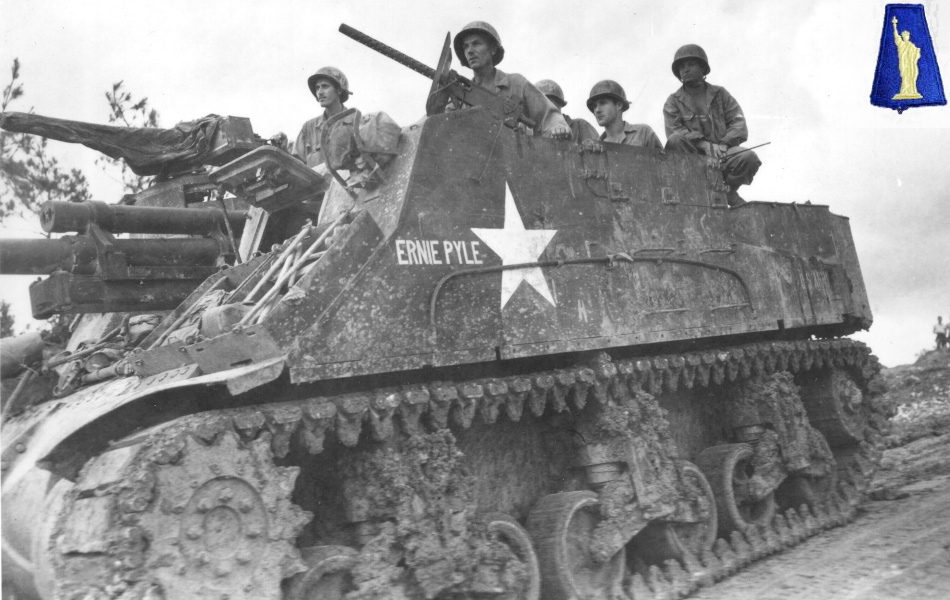
The 77th Infantry Division, veterans of Guam and Leyte, were the first troops to engage in "Operation Iceberg", the codename for the Okinawa Campaign. In order to establish an advanced naval base, the 77th ID assaulted several of the Kerama Islands on 26 March 1945, a week before the invasion of the primary target, Okinawa, on 1 April. "All together, the 77th struck in six separate amphibious assault landings and followed up with nine more to capture the islets and secure the protected anchorage." Along with their landings at Guam and Leyte, including their decisive end-run assault near Ormoc, this has to be some kind of amphibious record. On 16th April, the division invaded Ie Shima, and secured the island by the 26th, after which it became a US air base, described by some as "an unsinkable aircraft carrier". The Ie Shima operation was more or less forgotten in the shadow of the "Typhoon of Steel" that was Okinawa, but the 77th suffered over 1100 casualties including 217 KIA taking the small island. The photo is dated 31 May 1945, and captioned, "Shuri Okinawa...A self-propelled 105 mm Artillery gun, bears the name of Ernie Pyle, in tribute to the beloved correspondent who lost his life with the 77th on Ie Shima. The carrier was on its way to the front when photographed." A few days after Ie Shima, the 77th ID deployed to Okinawa and took its place on the front lines, relieving the exhausted 96th ID. The 77th was known as the “Statue of Liberty Division” and their insignia (inset) can be seen on the helmets of some of the gunners. "Painting of the trapezoid on the helmets was considered a special ceremony." Reading the Division history, "Ours to Hold it High", and its Okinawa Operations Report, one gets the impression that the regimental cannon companies were entirely equipped with M8 Howitzer Motor Carriages during their campaigns up to this time. "The SP Gun, 75mm, M-8 was used as well as the M-18 [just prior to the Okinawa Campaign, the antitank company was equipped with eight]. Both weapons were used extensively for sealing caves and, in addition, performed valuable direct support fire for the infantry. The M-8 was used for both direct and indirect firing and both weapons delivered flanking support fire and overhead support fire from positions on high ground." The division preferred "a vehicle of less than 20 tons" for the terrain conditions under which it operated and both the M8 HMC and the M18 TD fit the bill. The first mention of the use of M7s that we have seen in the 77th ID records is from "Second to None", the history of the 305th Infantry Regiment. On 17 May 1945, "So far as we have been able to learn, the 305th in conjunction with the 307th was the first organization in the Pacific Area to make a night attack against a strongly held Japanese position...The RCT received excellent support from our light, medium, and heavy artillery, our M4s, M7s, M8s, M18s, and flame-throwing tanks." The Division must have had some experience with the M7, but rejected it for future operations, "The Carriage, Motor 105mm How, M-7, has a turret too open and is too heavy to provide the flexibility desired." In any case, pending further research, we would guess that the 77th ID's cannon companies received a few M7s as replacements while fighting on Okinawa, and "Ernie Pyle" was likely one of them. Note the added Browning .30 caliber machine gun with shield. The angle of this photo permits us to see that the grouser boxes are in "mod 2" configuration with the retaining bars of the outer box running through the little footman loops.
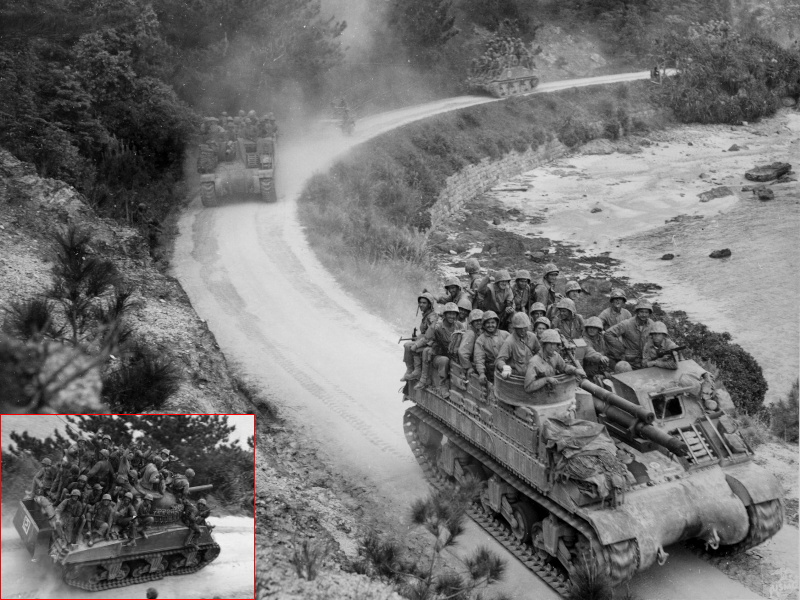
Period photos suggest that M7s were first used by the US Marine Corps on Okinawa, site of "The Last Battle." The III Amphibious Corps selected the 1st and 6th Marine Divisions for the 1 April 1945 assault, while the 2d Marine Division served as a floating reserve. "Marines in the Victory on Okinawa", part of the USMC 50th Anniversary commemorative series, states that "The Marine divisions preparing to assault Okinawa experienced yet another organizational change, the fourth of the war...Although the "G-Series" T/O [Table of Organization and Equipment] would not become official until a month after the landing, the divisions had already complied with most of the changes. The overall size of each division increased from 17,465 to 19,176...The most timely weapons change occurred with the replacement of the 75mm "half-tracks" with the newly developed [sic] M-7 105mm self-propelled howitzer--four to each regiment. Purists in the artillery regiments tended to sniff at these weapons, deployed by the infantry not as massed howitzers but rather as direct-fire, open-sights "siege guns" against Okinawa's thousands of fortified caves, but the riflemen soon swore by them." The Marines and indeed the entire Tenth Army were taken aback when the landings went virtually unopposed. Almost immediately, the 6th Marine Division was ordered north to capture the Motobu Peninsula for starters, with the ultimate goal of conquering all of northern Okinawa, fully 2/3rds of the island. The photo above is captioned "Tank borne infantry Marines of the Twenty-Ninth regiment [6th MarDiv] race for the town of Ghuta [sic] to occupy the Okinawa village before the Japanese forces take it." No date is given, but we believe that the caption writer was actually referring to the town of Chuta, which the 29th Marines took on 6 April. Both M7s can be seen with shallow pulpits which we take to indicate 1942 production, so not exactly "newly developed." It is thought that the 6th MarDiv drew their Priests around the time that the division was activated on Guadalcanal in September 1944. We suspect that the extended end connectors, folding armor modification and the track link "armor" may have been retrofitted at that time. The lead M7 is noted with an antenna suggesting that a radio was installed. Marine Divisions did not have cannon companies with 6 M7s like many Army Infantry Divisions. Rather, 4 were placed in each of the regimental weapons companies. Note that the rearmost "taxi" in the column is a Sherman tank. It would appear that shortly after snapping this M7 photo, the photographer, PFC Robert Keller, took the iconic image (inset) of exuberant Marines greeting him as they passed.
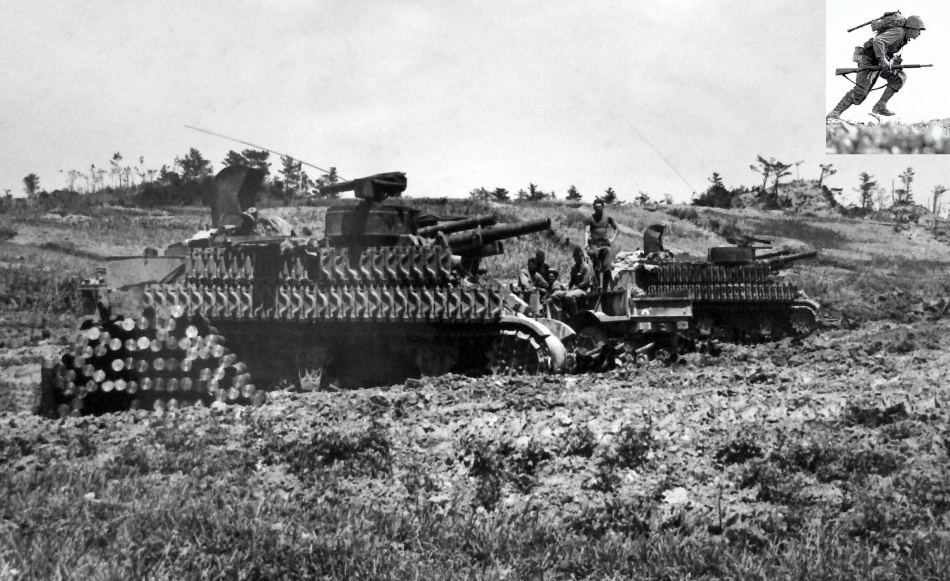
This USMC photo is simply captioned "M-7 tank destroyers are used as artillery. May 12, 1945 Okinawa" and PFC Bob Bailey is listed as the photographer. Bailey was "embedded" with the 1st Marine Division and 2 days earlier had photographed PFC Paul E. Ison, a demolitions man with L Company, 3rd Battalion, 5th Marines as he sprinted across what came to be known as "Death Valley" during the bloody struggle for Wilson's Ridge from the 3rd to the 11th of May. After the "Flag Raising at Iwo Jima", Bailey's photo (inset) is probably the most well-known WW II USMC image. From Bailey's photographer credit, we identify the M7s as belonging to one of the regimental weapons companies of the 1st MarDiv. The 12 May date would suggest that the Priests were in support of the 7th Marine Regiment who relieved the exhausted 5th Marines, and captured the next objective, Dakeshi Ridge on the 12th after 2 days of extremely costly assaults. Like many USMC AFVs, these M7s are retrofitted with track "armor." Again, we see 1942 era shallow pulpits. We might mention here that ALCO produced 615 M7s in November and 566 in December 1942. These were by far the highest production months and represent fully 1/3rd of the company's total output of 3314 units from April 1942 through October 1944. Both have antennas which are noted to be installed on US Priests far more often in the PTO. Both can be seen with forward wading stacks. The "Deep Water Fording" kit produced in the US starting in late 1943 provided a forward stack to cover the air intake on M4 and M4A1 (radial) Shermans along with a rear stack. However, on the M7, only a rear stack was provided. The intakes on the M7's engine deck were simply sealed up according to both the 1944 and 1945 Technical Manuals. The stacks in the photo look like ones from the US kit, so perhaps the Marines adapted the M4/M4A1 kits to fit on their M7s? Or an alternate type was made in the Pacific Theater, possibly in Hawaii?
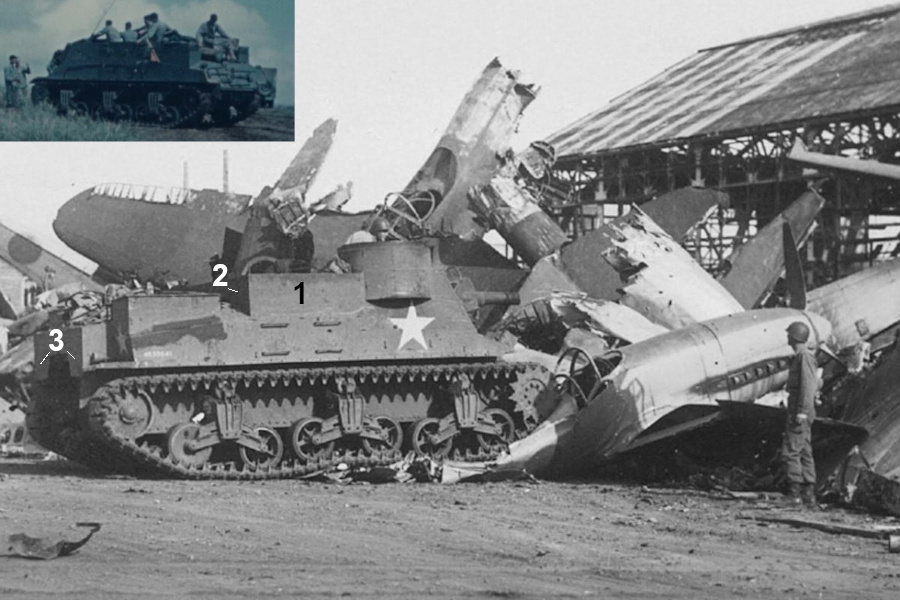
For the planned invasion of Japan, it was recommended that Infantry Division cannon companies be equipped with "M7 Series (or M37) 105 MM How, Mtr Carriage." This particular document does not specify the use of Ford engines (M7B1s) although that was the case with the Shermans (M4A3 with wide tracks) slated for "Operation Olympic." We would note that there is some film footage of the 3rd Marine Division training with M7B1s (inset) on Guam in late May 1945. They were scheduled to assault Kagoshima, Japan on X-Day along with the 2nd and 5th MarDivs. At any rate, despite its "Substitute Standard" classification, the M7 series continued in service for a number of years after WW II. Here we see a Priest performing the post war duty of "turning swords into ploughshares". After the surrender of Japan, a number of US Divisions occupied the country. One of their assignments was to destroy Japanese military equipment. The photo shows "The sole Ki-78 [prototype] being crushed by American forces at Gifu Air Field, after the war, in 1945." The 25th Infantry Division arrived in Japan in November 1945, and the Gifu prefecture was the responsibility of its 27th Infantry Regiment. Earlier we featured a photo of USA 4039654 of the 25th Infantry Division in action on Luzon in April 1945 and noted that it had a field modification in which a plate was neatly welded on. The M7 "demolition vehicle" appears to have a similar mod (1) and it can be seen that it extended across the rear (2) of the fighting compartment. Another field mod seen in wartime photos of a few 37th ID M7s is the additional protection for the air cleaners (3).
British Use in China-Burma-India [CBI] Theater of Operations
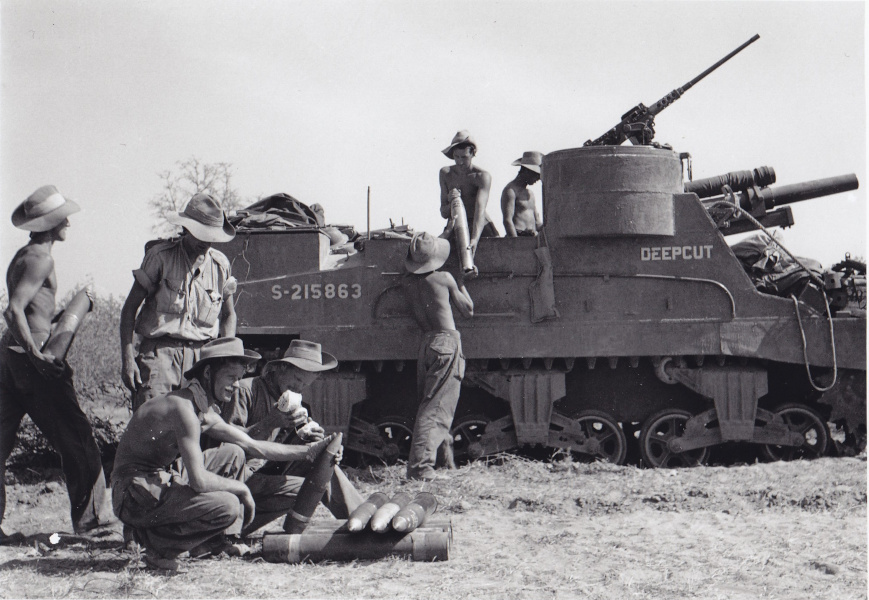
Earlier, we cited an April 1943 Munitions Assignment Board document that had it that 84 M7s were on the way from the US to India. We suspect that this may have been the total number shipped. While the IWM's collections include a number of photos and films showing M7s serving in Burma in February and March 1945, we have not found much detailed information about the employment of Priests in the CBI. It would appear that their use in combat was limited to the 18th Field Regiment (Self-Propelled), Royal Artillery. Originally a towed artillery regiment that fought with the BEF in France, the unit was evacuated from Dunkirk in 1940. Subsequently replenished, in February 1941 it was restructured from two to three batteries (the 59th, 93rd and 94/95th Batteries), before being transferred to India, arriving in Bombay in November 1942. According to the "The Royal Artillery 1939-1945" website, the regiment became self-propelled in December 1943 when it was authorized "24 x 105mm Self Propelled M7 Priest, 10 x Sherman Observation Post." The same source states that in January 1945, its vehicle strength was reduced to "16 x 105 mm Self Propelled M7 Priest", which seems significantly under-strength, but perhaps reflects the limited number of operable Priests available in theater at the time, or the maximum number that the Army could support with 105mm ammunition during the upcoming campaign in Burma. The above photo was taken on 7 March 1945, and shows S-215863, “DEEPCUT” of D Troop, 93 Battery. We can only assume that this vehicle was named after the village of Deepcut in Surrey, as some of the other Priests of the regiment are seen with the names of other British villages, such as Dunkirk, Docking and Chudleigh. All of the members of the crew are wearing the standard British issue WWII Bush Hat, pinned up on one side, and while this headgear is typically associated with Australian soldiers, the “slouch hat” was also worn by numerous British units, and we would point out that no Australian Army troops served in the CBI. The "deep" pulpit and the "plain" sprocket suggest that this was a 1943 production M7, and likely factory installed with the canvas cover support frame modification. The recuperator housing appears to have had the hemp rope wrap-around treatment covered over with a piece of fabric. Other IWM photos of "DEEPCUT" show the M3 Grant type sand shield completely intact on the left side. Courtesy of Imperial War Museum Photo SE3366.
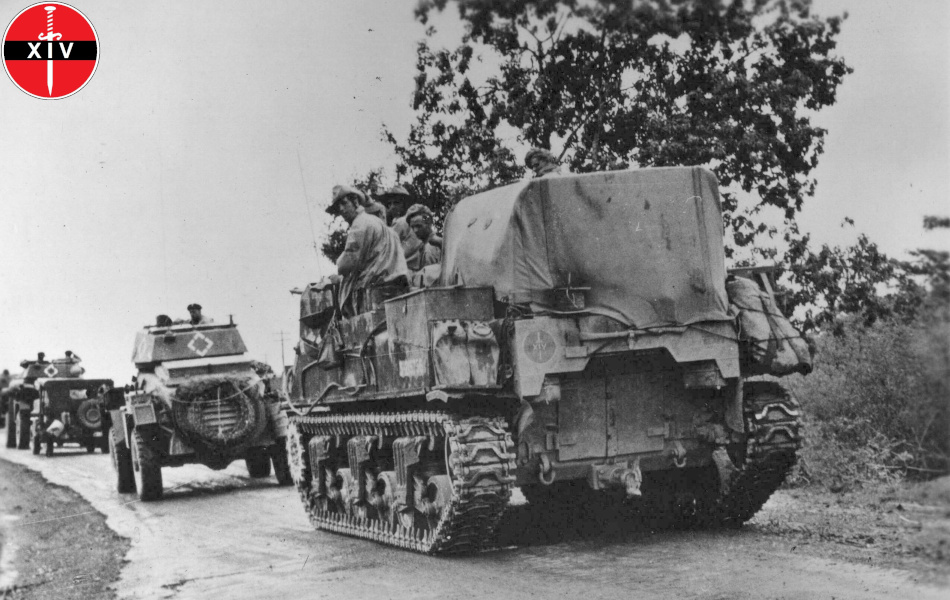
In "My Burma Campaign" Rex Wait describes the regiment and its mission, "...equipped with the American 105mm howitzer on a Sherman tank chassis...At the time we were sent into Burma, in December 1944, I was a humble subaltern, the Troop Leader of Fox Troop, 94/95 Battery. Being something of an oddity, our Regiment was not assigned to any particular Division. It came directly under the Brigadier, Royal Artillery, at 14th Army H.Q., and we wore the 14th Army flash on our shoulders. The Regiment could thus be made available to support the armoured units of any of the Brigades in the Divisions of 33 Corps and 4 Corps as the Army Commander might require." As the sole self-propelled artillery unit in the CBI, the regiment was a 14th Army asset, and its batteries were individually seconded out amongst the army’s brigades and divisions as required. The above photo shows a Priest of the regiment headed for Rangoon, after the city had fallen according to the undated Office of War Information caption, "Allies in Rangoon. Climax to the brilliant achievements of Indian and British troops in Burma, was the fall of the capital, Rangoon. Smashed and disorganized in their flight south, the Japanese gave up the city without resistance." In conjunction with the attack of the 14th Army from the north, the Allies launched Operation Dracula, an airborne and amphibious assault on the city. Heavy resistance was expected from "a deeply entrenched Japanese "suicide garrison"" but the disorganized enemy evacuated Rangoon, and the 26th Indian Division liberated it without a fight on 2 May 1945. The 14th [XIV] Army formation marking (inset) can be seen on the Priest's upper rear hull plate. Many of the regiment’s vehicles display names beginning with the troop letter on the hull side and a close examination of the photo appears to show this M7 to have a name beginning with the letters "CE...", hence we believe it served with C Troop, 93 Battery. The first part of the WD Number can be read as "S-215XXX", so in the same range as “DEEPCUT”. Like “DEEPCUT”, it strikes us as a 1943 production M7. Neither is seen with the added ammunition protection, either done in the field or from the US modification kit.
Postwar Use

The photo above is dated 23 April 1951 and captioned, "Elements of the 19th Inf Regt, 24th US Inf Div and a tank of Co D, 6th Armored Bn attached to the 24th US Inf Div move into new positions in a counter-offensive to the enemy's attempt for a push south of the 38th Parallel in Korea." The Korean War began on 25 June 1950. The first 7 months can be thought of as the "active" period of the war, characterized by the UN retreat to the Pusan Perimeter, the Inchon landing and breakout in mid-September, and the "bug out" from North Korea in the face of the Chinese intervention and attack in November. After that, there were a series of inconclusive offensives and counteroffensives, followed by a bloody stalemate in which the conflict ebbed and flowed around the 38th Parallel. Oddly, the M7 series does not seem to have been employed in Korea until the Spring of 1951. Indeed, the photo above is the earliest dated "combat shot" we have found. The caption is somewhat baffling as it identifies the M7B1 as a "tank" of "Co D, 6th Armored Bn." The writer was likely referring to the 6th Medium Tank Battalion, which was detached from the 2nd Armored Division at Fort Hood and arrived in Korea in August 1950. After a period of organization and combat readiness training, it was assigned as the organic tank battalion of the battered 24th ID, the first US Army unit rushed from Japan to Korea after the start of the war. The 6th MTB was the first to deploy with the "new" M46 Patton Tank which was basically an M26 Pershing conversion rebuilt with an 810 HP engine, new transmission, new gun with bore evacuator, and improvements to the suspension. On 17 September 1950, the 24th ID's "War Diary and Command Report" lists the 6th MTB's AFV holdings as 72 M46s, 6 M45s, 2 M24s (light tanks) and 6 M32s (tank recovery vehicles). The M45 was the 105mm armed variant of the M26 Pershing, intended to replace the M4A3(105)HVSS Sherman in the US Army inventory at the end of WW II. The 24th ID records mention the 6th MTB's "Assault Gun Platoon" on numerous occasions. We believe that the M45s were in the Assault Gun Platoon of the 6th MTB's Headquarters Company as authorized in a 1949 Medium Tank Table of Organization and Equipment, the last US Army TO&E that included 105mm Assault Guns. This configuration appears to have been unique to the 6th MTB, that is, we don't find evidence that any of the other tank battalions that deployed to Korea had Assault Gun Platoons. There are a small number of Signal Corps photos that show M45s with tactical markings of the HQ and Service Company, 6th MTB fording the Geumho River at the start of the breakout from the Pusan perimeter in mid-September 1950. In addition, a 1951 Operations Research Office Report entitled "The Employment of Armor in Korea," has it that a total of 8 M45s were "fielded" in Korea, with all "Lost" by 21 January 1951. There is no mention of the use of M7s in the scant records of the 6th MTB that we have searched, but we might theorize that they replaced the "lost" M45s in the Assault Gun Platoon. Note the "tiger face" painted on the right front fender. Before the start of "Operation Ripper", the US offensive of early March 1951, these sorts of animal faces were instructed (or perhaps simply authorized) to be painted on the fronts of US tanks in Korea. It was thought that the sight of such beasts would scare and demoralize the superstitious enemy. As for other markings, the Priest appears to have "Annie Oakley" painted under the pulpit and "A24" painted on the pulpit. To our eyes, it looks like some other tactical markings were scrubbed from the pulpit and a "6" was painted over top. Another photo of this scene shows another M7B1 with "tiger face" and "2" painted on the pulpit. If any readers can shed light on the unit of these M7B1s, we would be pleased to have a report.
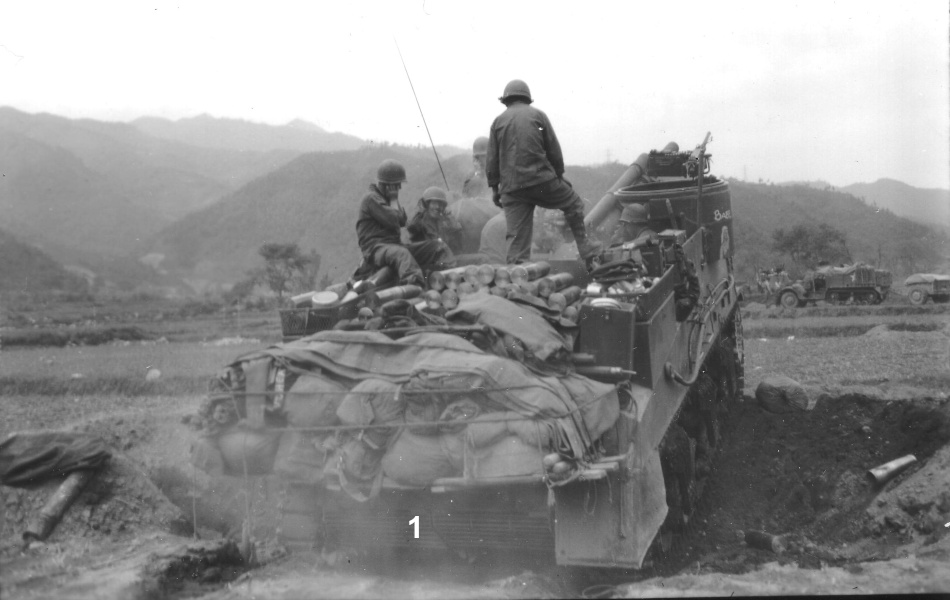
We can document that at least four National Guard Armored Field Artillery Battalions equipped with M7s were shipped to Korea in early 1951. Most of the information comes from oral or written histories of individual soldiers. For instance, Sgt. Conrad Grimshaw of Service Battery of the 213th Armored Field Artillery Battalion wrote a memoir about his 6 months' service in Korea. The 213th "Mormon Battalion" was composed of guardsmen from small towns in southern Utah. They shipped out in late January 1951 aboard the USNS General M.C. Meigs. Grimshaw reported, "Aboard the ship were the following units: 213 Armored Field Artillery Battalion; 300 Armored Field Artillery Battalion; 987th Armored Field Artillery Battalion" among others. These three battalions were initially equipped with M7s, and the evidence suggests that they brought their Priests with them. The Meigs arrived in Pusan in mid-February and the 213th AFA Bn set up in an assembly area nearby where the unit continued to organize and undergo combat readiness training. In early April, the battalion was shipped to Inchon by LST and finally deployed on the front lines near Kapyong. Battery B fired the 213th AFA Bn's first rounds in combat on 22 April at the start of the Chinese Spring Offensive, 22-27 April 1951. In this action, the 213th was placed in support of a number of the hard-pressed units of the IX Corps including the 27th British Commonwealth Brigade made up of British, Canadian and Australian troops. UN forces gave way at first and Sgt. Grimshaw reported that during the "bug out", one howitzer was left behind when it slipped off the road and could not be recovered. The Signal Corps photo above is dated 25 May 1951 and captioned, "Men of the 1st howitzer platoon, B Btry, 213th Armd FA, IX Corps, fire into enemy positions north of KapYong, Korea." This M7B1 is installed with the armored exhaust deflector (1) which we suspect was retrofitted by modification kit. A name beginning with "Babe" and a female figure can be seen painted on the pulpit. The Priest is "ramped up" to obtain a bit more elevation. GI snapshots show that the 213th had a mix of M7B1s such as "Babe" along with M7s, including one or two Federal Machine M7s with E9 suspension. The Chinese/North Korean offensives of April and May ultimately failed, and UN forces went over to the offensive in late May. Once again, the 213th AFA Bn found itself back in the Kapyong Valley which is reflected in the photo. On 27 May 1951, Headquarters and A Battery were attacked by a "force of more than 4,000 Chinese" who had been bypassed by the UN offensive and were attempting to retreat back to their own lines. The 240 Utahns somehow managed to hold off the Chinese throughout the night, and early the next morning the unit sent out a combat patrol "using one of its self-propelled artillery guns as a tank." Ultimately, this action "resulted in the capture of 831 prisoners and inflicted hundreds of casualties on the enemy." Incredibly the gunners suffered "no significant friendly casualties." HQ Battery and A Battery were awarded the Presidential Unit Citation. The events of this epic stand are related by a number of the participants in the documentary film "Miracle at KapYong: The Story of the 213th." (link) In October of 1951, the 213th AFA Bn turned in its Priests and was issued "155mm trail models pulled by tractors." Sgt. Grimshaw reported that this was due to a shortage of 105mm ammunition. In May 1953, the unit was issued some of the massive 240mm howitzers and "After that, they fired both 155mm and 240mm guns."
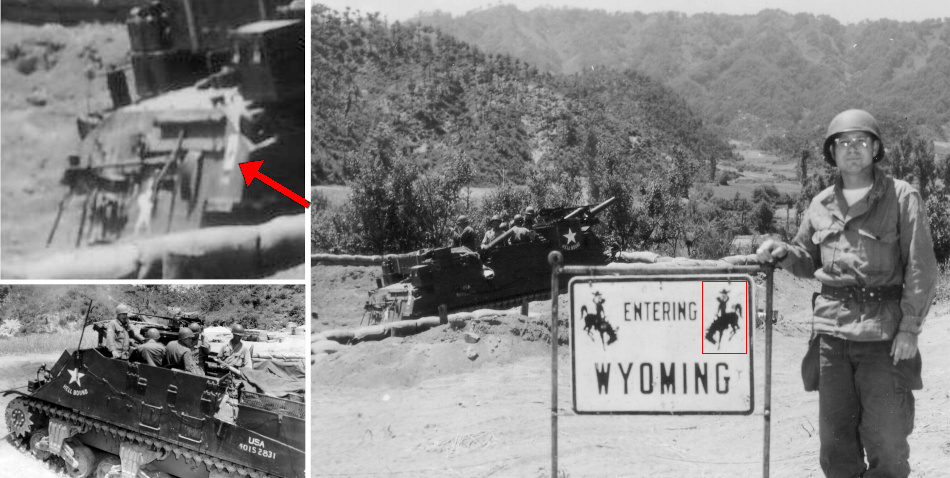
The 300th Armored Field Artillery Battalion was a Wyoming National Guard unit that was also shipped to Korea aboard the General M.C. Meigs, arriving in mid-February 1951. After a period of combat readiness training, the unit was deployed on the front lines and conducted its first fire mission on 15 May in support of the 2d Infantry Division during the Battle of the Soyang River. For the next 7 days, the "Cowboy Cannoneers" "delivered devastating artillery fire...inflicting thousands of enemy casualties." In this its first combat action, the 300th was awarded the Presidential Unit Citation. The caption of the photo is dated 1 July 1951 and is entitled "Extending Wyoming's Boundaries." The 300th AFA Bn's commanding officer, Lt. Col John Raper is shown posing with a Wyoming Highway Department road sign that "his men spirited out of the States. The sign has followed the "Cowboy Artillery" all over Korea. In the background, the crew of a 105MM self-propelled howitzer prepares to fire a mission." The "bucking horse and rider" as outlined on the highway sign, is basically a symbol of Wyoming that was first placed on automobile license plates in 1936. It can be seen painted on the Priest's upper rear hull plate (arrow). Possibly based on this photo, the highway signs are specially made for units of the Wyoming National Guard to take with them wherever they go. The M7B1 carries the name "HELL BOUND" and the Registration Number can be read as USA 40152831 (December 1944 production) in another SC photo of this scene (inset). According to that photo's caption, "HELL BOUND" was with B Battery, and the 5 men pictured servicing the piece were from Cody, Wyoming. No location is given in the captions, but based on the date, it is thought that the 300th would have been in the area around the Hwacheon Reservoir and Yanggu firing missions in support of the 7th ROK Division or 1st Marine Division on "Line Kansas" just above the infamous 38th Parallel. According to the Army Historical Foundation, "The 300th remained in Korea for the remainder of the war, taking part in battles at the Punchbowl, Bunker Hill, Bloody Ridge, and Heartbreak Ridge. In the final weeks of the conflict, the 300th earned a second Presidential Unit Citation for actions at Kumsong. In all, the 300th fired 514,036 105mm howitzer rounds in 805 days of combat." From "fired 514,036 105mm howitzer rounds" we take it that the unit retained its Priests throughout its service in Korea. A few GI photos suggest that, at some point, the 300 AFA Bn was issued some "high angle fire" M7s as replacements.
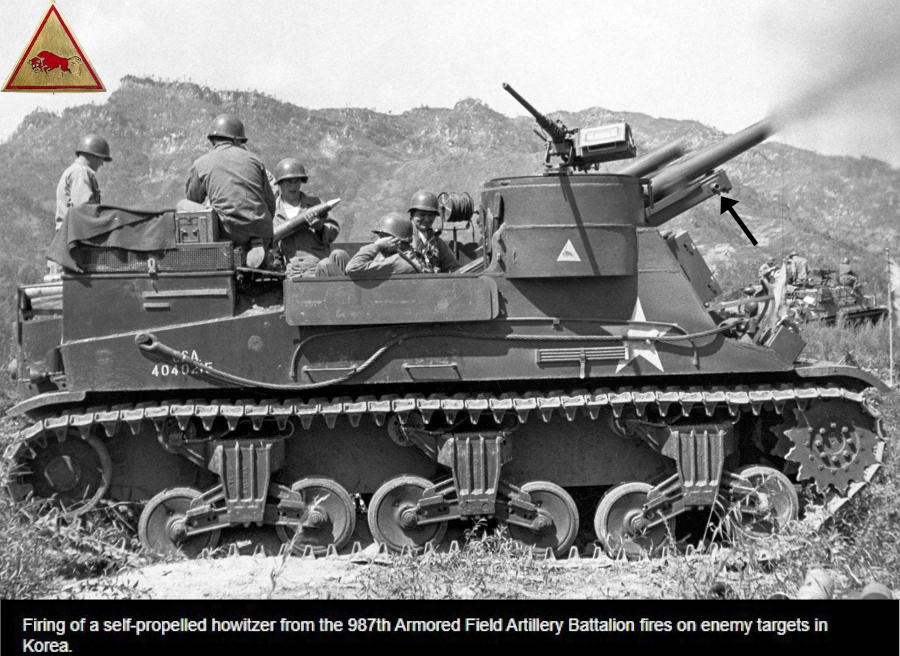
The 987th Armored Field Artillery Battalion, an Ohio National Guard unit, was the third AFA Bn listed as having been transported to Korea on the General M.C. Meigs. Warrant Officer James C. Neely wrote a memoir describing what happened when the 987th was ordered forward to support a reconnaissance in force by the 6th Republic of Korea and the 1st Marine Divisions. It is not clear if this was the unit's combat debut, or if they had been involved in earlier actions, but on 22 April 1951, the first day of the Chinese Spring Offensive, the 6th ROK Division routed under the weight of the massive attack which left the 987th AFA Bn exposed in an untenable position "trapped on a one-way road" between the towns of Sachang-ni and Chunchon-ni. In the pandemonium of the ensuing "bug out", "the battalion was unable to extricate...nine guns, so the officers ran these over the cliff into the river gorge, preventing the Chinese from utilizing these as captured artillery pieces". Neely states that the battalion's surviving M7s supported the 1st Marine Division in a rear-guard action and "Hold Mojin bridge until all elements are crossed." The 987th continued to use M7s until they were reportedly replaced with M43 8-inch self-propelled howitzers in October 1952. An item in a "Combat Information Bulletin" submitted by the 987th and dated September 1952 is headed "Use of Modified 105-MM Howitzer" and states "Approximately 75% of the fires of the battalion were high-angle fire. No difficulties were experienced using the modified 105-mm howitzer, self-propelled, M7 (with well). Frequent shifting of the carriage is necessary because of the limited traverse at high angles". The unit, which had lost 9 or 10 of its original M7s, appears to have received some replacements that were rebuilt at the Tokyo Ordnance Depot and specifically modified for high-angle fire. The insignia of the 987th, a red bull on a yellow triangle (inset) is noted to have been painted on the sides of their M7s. This Priest can be seen as USA 4040215, indicating that it was produced by ALCO in October 1944, their last month of M7 production. Note the fitting on the gun cradle (arrow) which we take to be a recognition feature of an M7 modified for high-angle fire as explained in the next caption. This Priest has also been retrofitted with extended end connectors. The louvers on the stowage box seen here are not in the standard 1944 M7 configuration, suggesting that the original may have been damaged and replaced, perhaps at the TOD. James Neely's memoir includes an internal link to the personal photos of MSgt John Engel of B Battery which appear to have been taken throughout 1952 in the central sector of the front. A pair of high-angle modified M7s named "Brown Noser" and "Brown Bomber" are featured. In addition, there is a photo of an M43 HMC that is dated "Oct 1952." Photo courtesy of the Ohio National Guard Heritage Center.
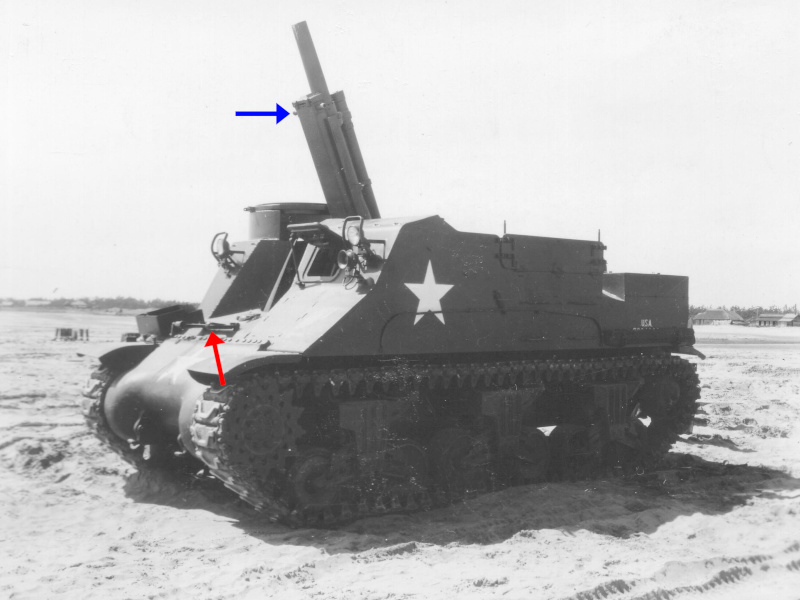
The photo above is dated 15 March 1951 and simply
captioned, "A self-propelled 105MM Howitzer M7 modified to permit high
angle fire." No location is given, although we suspect the photo may
show the pilot model on a firing range, possibly in Japan. Note that the
gun travel lock (red arrow) has been modified and repositioned from the
fighting compartment to the front of the vehicle. Two male fittings
(blue arrow) have been added to the gun's cradle to secure the travel
lock. It is thought that the rear half of the false floor in the
fighting compartment was removed in order to facilitate high angle fire.
That might explain the meaning of "with well" in the previous caption.
Of course, this would have necessitated a rearrangement of the
ammunition stowage. The caption does not include the nomenclature
"M7J1", but we would assume that is what this unit is - an M7 rebuilt
and modified for high angle fire at the Tokyo Ordnance Depot. If they
can be seen in photos, we take the gun travel lock on the front and the
fittings on the gun cradle to be recognition features of the high-angle
modification. This is an early production M7 with the side hinged
stowage bins. We assume that it was retrofitted with the folding armor
and canvas cover mods, probably during WW II. It can be seen that the
original small grouser box was replaced with the one that was somewhat
larger and taller and "notched". This M7 would have been built with a
siren, not the automobile type horn seen here. The M4 bogies with the
"final" type of track skids were likely retrofits as well. The placement
of the stars appears to have been typical of M7s rebuilt by the Tokyo
Ordnance Depot.
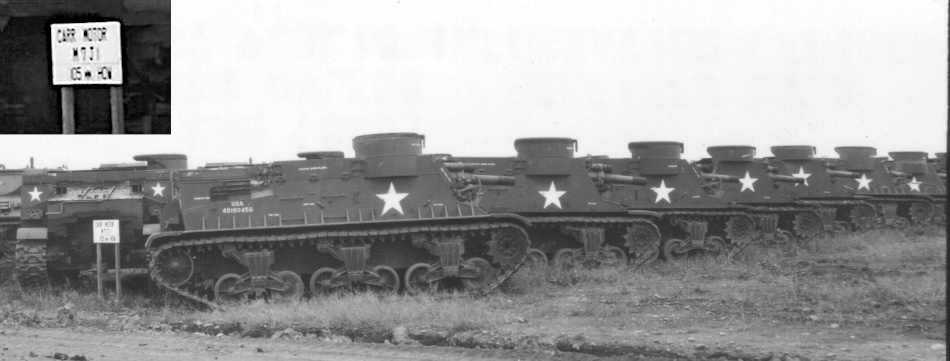
We do not know when the nomenclature "M7J1" was adopted but assume that the "J" refers to Japan. The Signal Corps photo above is dated 29 September 1954 and captioned, "Combat vehicle storage in Tokorozawa Ordnance sub depot storage area in Japan." The sign on the left reads "Carr Motor M7J1 105mm How" (inset) and there are at least 8 Priests in the shot. We suspect that the 105mm guns are attached to the front travel locks. All of the M7s appear to have Extended End Connectors installed, which, judging by their presence in period photos, may have been a requirement for M7s rebuilt at the Tokyo Ordnance Depot. The unit in the center can be seen as USA 40190456 which indicates that it was produced by Federal Machine & Welder in May 1945. We consider the flat fender braces and the "E9 hole" in the sprocket to be recognition features of FMW M7s. Thus, we take it that there is another example off to the right. Note the size and placement of the stars with a small divergence on the shallow pulpit jobs. The Ordnance Technical Committee recommended that the M7 and M7J1 be declared obsolete on 20 April 1955. In the discussion, it was noted that, "The M7J1, a modified M7 authorized in FECOM [Far East Command], was later disapproved by OCAFF [Office of the Chief of Army Field Forces]. The vehicle incorporated an emergency fix to allow for high angle fire." The number of M7J1 conversions is not given, although the doc does state that there were 1254 M7s and M7J1s on hand in the US inventory worldwide, with most in depots in "Unserviceable" condition. Although the OCM does not express it outright, the implication is that all M7J1s were converted from M7s, that is with radial engines. We wonder about that since we have shown that there were a number of M7B1s deployed to Korea and can't help but think that some might have been shipped to the Tokyo OD for rebuild. Of interest is that the M7B1 was not being declared obsolete at this point. Instead, it was recommended that the remaining M7B1s be rehabilitated and rebuilt for high angle fire to M7B2 standard. This appears to have been done to satisfy US Army requirements while waiting for the long delayed T98E1/M52 105mm Self-Propelled Howitzer to enter production.
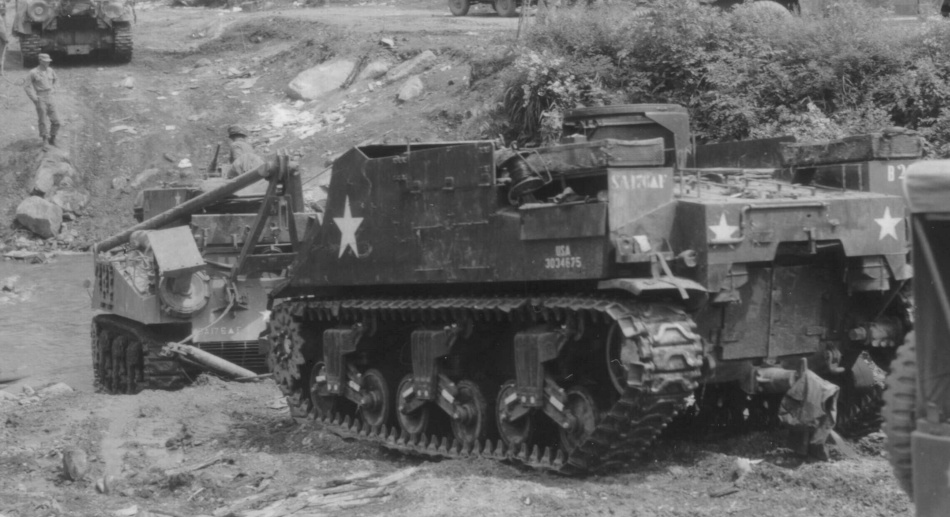
The 176th Armored Field Artillery Battalion was a Pennsylvania National Guard outfit that had only 6 weeks of training at Camp Carson, Colorado before being shipped out to Korea. The 176th arrived at Pusan in mid-February 1951 and underwent an additional 5 weeks of training at a nearby camp, after which it was shipped by LST to Inchon where it was attached to the 25th Infantry Division. According to an account by Capt. M. W. Goss, battalion S-3, "On 7 April 1951, the battalion fired its first round of 105mm in anger. They were attached to the 25th Division, reinforcing the fires of the 159th FA Bn in support of the 24th Infantry regiment." If the date is accurate, that would be the earliest use of the M7 in Korea we have encountered. The battalion supported the 25th ID and the 1st ROK ID throughout the Chinese Offensives of April and May 1951. It would appear that, like the 300th AFA Bn, the 176th fought with Priests to the end of the conflict. The photo is dated 17 July 1953, which was 10 days before the armistice/cease fire. The caption reads, "Tank Retriever towing self-propelled gun carrier that is being reclaimed by "A" Btry, 176th FA Bn, Eighth Army, Korea. Equipment was destroyed prior to evacuation of area during heavy fighting with Chinese Communists in Korea." We've zoomed in on this M7 which can be seen with tactical markings of B Battery, 176th AFA Bn. The Registration Number can be read as USA 3034675 indicating an M7 produced in August 1942. The early side hinged stowage bins are still present although they have been topped with the "blanket baskets" typical of 1944/1945 production. The placement of the stars and the addition of EECs strike us as indicative of a Tokyo Ord. Depot rebuild job. We would speculate that this M7 and other AFVs of the 176th AFA Bn were abandoned during a "bug out" when they came to an impassable, rain swollen creek. This would have been at some point between 13 and 20 July 1953 during the final Chinese push of the Battle of the Kumsong Salient. In a recorded interview with his son in 2004, Corporal William Didycz says of the debacle, "We had lost everything: tanks, trucks, tents, everything but our skins, the clothes on our backs, and our rifles." Cpl. Didycz, who stated that he arrived as a replacement two days before the start of the final Chinese Offensive (ca. 11 June 1953), describes the M7s in an interesting way as "105 mm howitzers [that] were mounted on tank chassis. Howitzers are unique in that they could fire at a high trajectory, like over hills that Korea was full of. Being mounted on tank (M4A3 E8) [sic] chassis meant that we were mobile over terrain that trucks pulling howitzers couldn't negotiate. It was a great idea for a tactical weapon, but a lousy one for the men in it. Tanks themselves were death boxes; this was a death box without a lid." He goes on to relate how the battalion was quickly re-equipped in Seoul, "I couldn't believe that they had more of those ancient M4A3's [sic], but sure enough, they did. I was given a new deuce and a half (2-1/2 ton truck) loaded with supplies, and in short order we had formed a convoy of tanks, trucks, jeeps, and half-tracks and were on our way back north." We would observe that the gunners in the various accounts consistently refer to their M7s as "tanks."
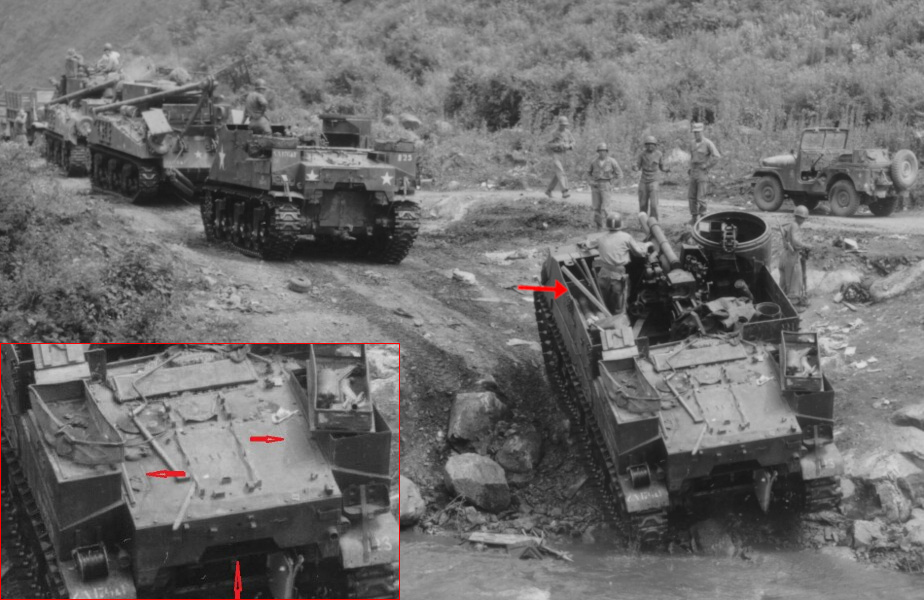
Here we have a photo of another M7 of the 176th AFA Bn being recovered. This Priest looks to be damaged but certainly not "destroyed" as written in the caption. Since no towing cables are visible, this unit appears to be moving under its own power. From this angle, the 1944 M7 configuration of the engine deck can be seen. Further inspection shows louvers on the sponson stowage box. The high mounted grouser box is just visible on the glacis, which indicates a unit with "low" headlights. This combination of features surely identify this Priest as a 1944 production ALCO M7. However, an interesting oddity is visible in this photo - a notched upper rear hull plate, typical of 1942/43 production M7s. As mentioned previously, the notch was eliminated from the 1944 design and the upper rear hull plate went straight across. We have shown that some surviving 1944 M7s are seen with upper rear hull plates with the notches filled in, which appears to have been an effort to use excess parts from 1942/43 production. We have zoomed in on the engine deck in the inset, where it is possible to see the filler pieces used to blank off the rectangular holes of the "fuel tank compartment ventilating grilles" of 1942/43 production M7s, so the change was made there. We might hazard a guess that the notched upper rear hull plate slipped through the cracks when this M7 rolled off the line at ALCO. Some 105mm rounds can be seen stowed in a horizontal orientation (red arrow) on the left-hand side and there is a vertical metal plate visible, which we assume was installed to prevent the rounds from sliding forward. We believe that this was part of the reconfiguration of the ammo stowage when an M7 was converted for high angle fire. Although we can't document it, we would guess that most or all of the M7s rebuilt at the Tokyo Ord. Depot would have been modified for high angle fire, simply because that was what was wanted/required in the mountains of Korea. It is mentioned that the Tokyo Ordnance Depot was almost self-sufficient and was able to provide 75% of the materials it needed in house. Another possible explanation for the notch may be that the original upper rear hull plate was damaged and was replaced by another plate cannibalized from a 1942/43 M7. We would note that this M7 is not installed with the Barber-Colman type exhaust deflector or its fittings as used on 1944 M7s, but appears to have the earlier curved exhaust deflector. In any case, a pair of Tank Recovery Vehicles, one radial engine M32B1 and one Ford engine M32B3, can be seen involved in the recovery operation. It is thought that the armored field battalions would have been equipped with at least two such retrievers in the Service Company. The Chinese and North Koreans became masters of the art of infiltration, and artillery units were prime targets of their attacks since they accounted for perhaps as much as 3/4 of the casualties they suffered. An 8th Army Command Report states that "the enemy infiltrated to the rear of the artillery positions and placed a fire block on each side of the road, making it impossible for the artillery to move its vehicles and weapons through the road. As of May 1951, "The loss by US Artillery units has been 212 weapons and by Korean [ROK] Army units 196 weapons." Since the front lines in Korea were for the most part not continuous, UN artillery units had to learn the hard way how to "fort up" and provide for their own defense.

This Signal Corps photo is dated 28 May 1950, about a month before the start of the Korean War and is captioned, "Red River Arsenal Helps on MDAP [Mutual Defense Assistance Program] Parking Area: One of the vast parking areas of the vehicles that were returned to the United States upon cessation of hostilities of World War II. The vehicles have been "cocooned" and are periodically inspected. From these "stockpiles" the vehicles go through the process of being torn down and completely rebuilt. When leaving the paint shop after their final coat of paint, the vehicle is as serviceable and complete as a new one." Red River Army Depot is located near Texarkana, Texas and according to the US Army webpage, "In 1946, the depot was assigned the responsibility of storing combat vehicles returned from the war. Over 58,000 vehicles were stored on the depot and is believed to be one of the largest numbers ever stored at one installation." The Mutual Defense Assistance Act was signed into law on 6 October 1949 "To promote the Foreign Policy and provide for the defense and general welfare of the United States by furnishing military assistance to foreign countries." The act was primarily intended to provide assistance to members of the North Atlantic Treaty Organization which was established in April 1949. The treaty provides that each member state will come to the defense of any other member states that are attacked by third parties. MDAP was expanded to include assistance to other states whose defense was deemed important to the defense of the US. In the photo, the M36 series Tank Destroyers appear to be sealed or "cocooned" but the first two rows of Priests, which look to be M7B1s, can be seen with fighting compartments open to the weather, which would likely have made them much more difficult to refurbish. Some of the units in the far-right rows may be sealed. The high headlights and a few shallow pulpits visible would be indicative of M7s. The list is far from complete, but countries known to have received M7 series HMCs as MDAP include Belgium, France, Germany, Italy, Turkey and Yugoslavia. The MDAP documents we have scanned only go up to 31 January 1954, and as of that date, 561 "Carriage, Motor, 105mm, How. (all models)" had been shipped to the above-named countries. Most would have to have been M7 series, since the M37 HMCs meant to replace them were only produced in small numbers.
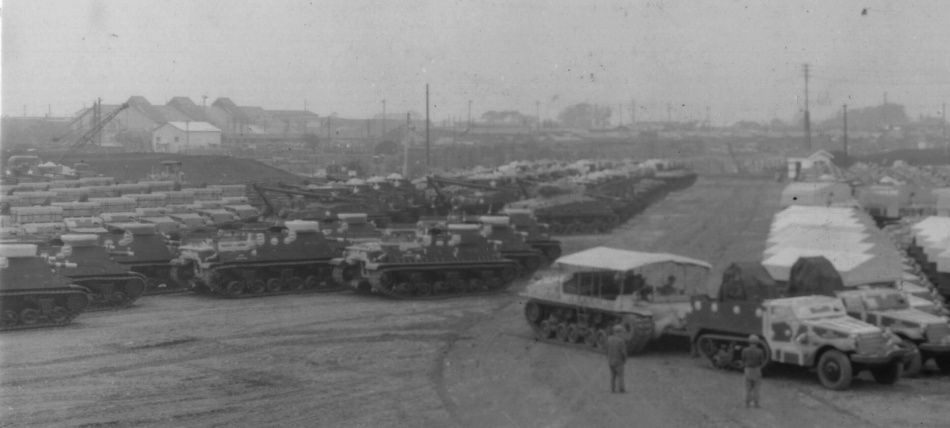
The photo above is dated 6 September 1955 and has the brief caption, "Repaired vehicle park at Tokyo Ordnance Depot, 8160th AU [Army Unit], Tokyo, Japan." There is what we take to be a Federal Machine and Welder M7 in the center of the photo. The vehicles can be seen sealed for overseas shipment such as was done at US Tank Depots. Note the cut down HVSS Sherman being used as a tractor. Starting in 1948, the Far East Command in Japan hired thousands of workers to repair and rehabilitate "Mountains of materiel collected from the battlefields of Guam, Saipan and Okinawa" as part of "Operation Roll Up." The salvaged guns, ammunition, trucks and Armored Fighting Vehicles may have provided the margin that saved UN Forces from defeat in the first 7 months of the Korean War. For its part, the Tokyo Ordnance Depot, which grew to be a huge, and pretty much self-sufficient operation, rebuilt hundreds of AFVs during the course of the Korean War. It was reported that the Depot could turn out two rebuilt Patton Tanks a day at a cost of $700 each. After the truce, the depot repaired and rebuilt tanks and other AFVs that were supplied to recipients of MDAP.
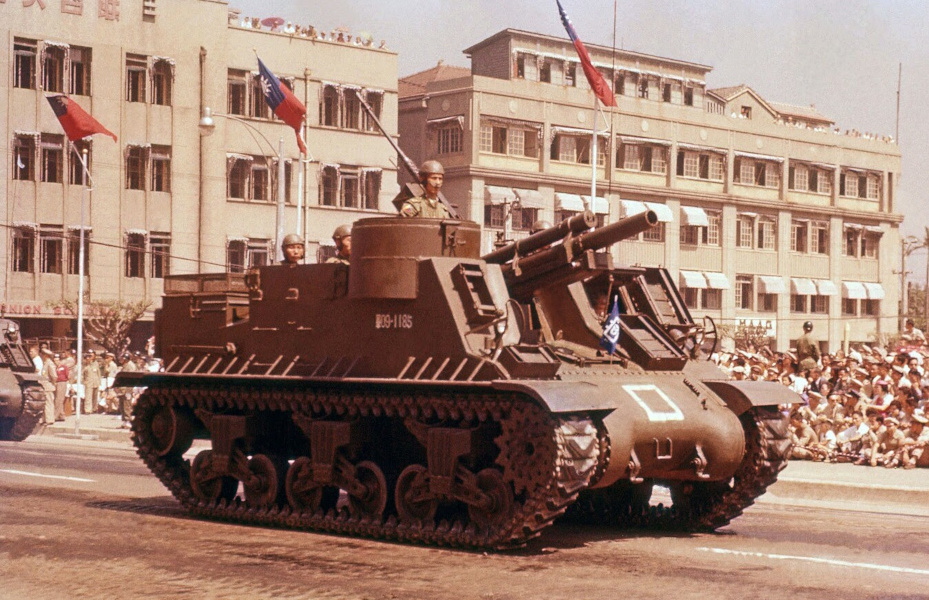
We don't have the MDAP figures for the Republic of China (Taiwan), but the island nation has received a good deal of military equipment from the US since the 1950s. The photo which was taken in Taipei during the "Double Ten" [October 10] Parade in 1956 shows a Federal Machine and Welder M7 sans EECs. The front mounted gun travel lock and the fittings on the gun cradle suggest that it had been converted to M7J1 in Japan. FMW M7s were produced from March to July 1945 and would have been built with the later E8543 "sharp nosed" type differential housings, but this unit has had that replaced by an earlier E4186 diff with a step in the middle that is typical of the M10 Tank Destroyer series. A bit of a 1942/1943 production M7 can be seen in the photo as well. This unit also had its original differential housing replaced, in this case with an E8543 "sharp nosed" diff. Photo courtesy of https://taipeiairstation.
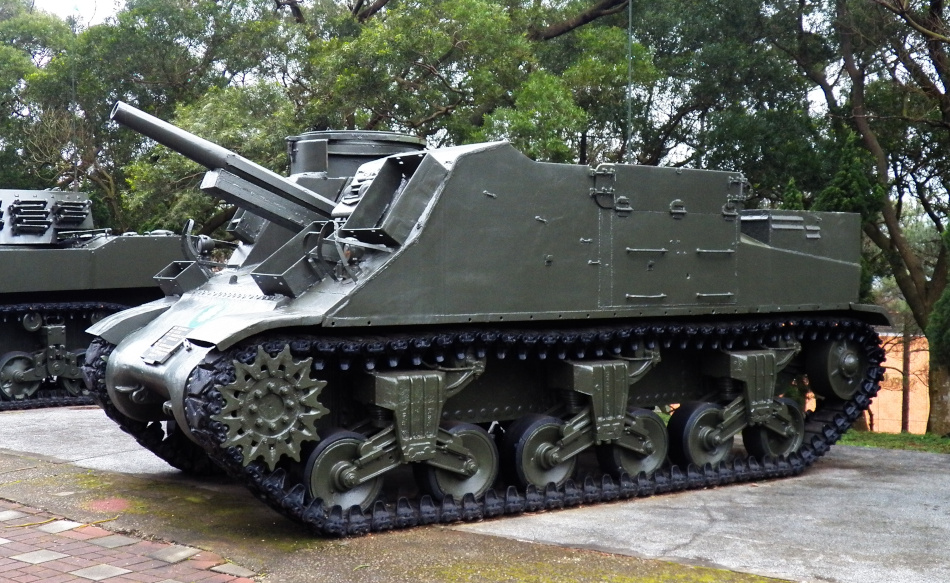
We believe that there may be a surviving M7J1 conversion on display in Taiwan at the Armor Academy and Military Base, HuKou, Hsinchu. We base that ID on the hinge fitting visible on the front deck, which was for the front gun travel lock. Indeed, there is an older photo of this M7 on the net which shows the gun travel lock still installed. The cradle of the 105mm gun appears to be made of lumber, so no male fittings there. The Priest can be seen as another example with what we call, for want a better term, "melted rivets" on the lower hull. The E8543 differential housing is noted to be the early type with the cast in steps. So, this may be an early 1944 production (March or April) ALCO M7, like SN 2843 at Ft. Sill. There are some weld scars on the side which may or may not have been for a retrofitted side door? Our Canadian friend, Jim Goetz, has a "bucket list" goal of seeing all of the surviving Shermans and variants in the world, and there is what appears to be an ALCO M4 at this museum as well. During his visit to Taiwan, Jim was disappointed to find that the Armor Academy was closed to foreign travelers due to the sensitive political situation in that area of the world. In any case, if any readers in Taiwan would be in the position to take a few photos of the upper rear hull plate, the engine deck and the fighting compartment, we would be happy to have your report. Photo courtesy of 玄史生 on Wikipedia Commons.
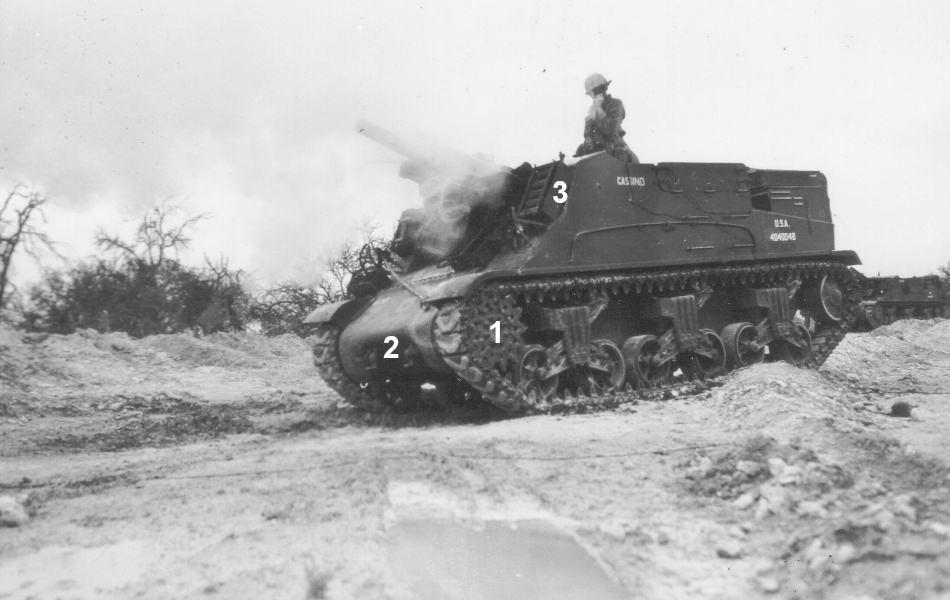
Meanwhile, back in the US, both the M7 and M7B1 continued in service with US Army training units. The photo shows an M7 of the 98th AFA Bn, 1st AD during the joint Army-Air Force Exercise Longhorn at Ft. Hood, Texas, 30 March 1952. The "Chief of Section" is identified as Sgt Glen Walls of Marion, Virginia. The M7 carries the name "CASSINO" and can be seen as USA 4040048, indicating ALCO August 1944 production. After nearly 8 years, this Priest still looks pretty close to "as built" although we would think that the original "plain" drive sprocket had been replaced with a sprocket typical of those made by Chrysler (1). The T-shaped towing shackles (2) begin to appear in Sherman production in October 1944, so these are likely postproduction retrofits as well. Judging by this photo, the larger grouser boxes appear to have been capable of holding 5 track blocks (3).

This photo is dated 17 August 1954, "Bouncin Betty Fires Away--Battery B, 161st Armored FA Bn, Liberal's unit of Kan [Kansas] National Guard fires off a round during a two-week field training session at Camp Carson, Colo." "Bouncin Betty" can be seen as 40152404 indicating PSC June 1944 production. The M7B1 has been retrofitted with an armored first aid box (arrow) attached to the rear of the right-side stowage bin, but "still" has the original sheet metal exhaust deflector. The road wheels are "mixed" with the first three being the "welded spoke with small holes" type, the next being the concave type and the last two being the original type welded spoke wheels. The men in and on the M7B1 are identified from left to right as "Sgt Darrel Hickey, Cpl John Leaming, Cpl Al Flores, Cpl Ronald Puliam, Sgt Dwain Dyson, 1st Lt Cecil E. Davis and behind Lt Davis is Cpl Wallace Molin." The two men in the lower right are unidentified, but there are a total of nine men in the shot. "FM 6-74, 105-mm Howitzer M2A1 on Motor Carriage M7B1 and M7B2" dated March 1954 appears to have changed the number of men in the crew of the M7B1 and M7B2 from seven to eight. It describes a "section" as the "personnel required to serve one gun and its equipment." And defines the makeup of the gun section as "Chief of Section (CS), A Gunner (G), assistant gunner (No. 1), Four cannoneers, numbered from 2 through 5, and A motor carriage driver (D)." The inset from the Field Manual shows the positions of the crew when the section is mounted.
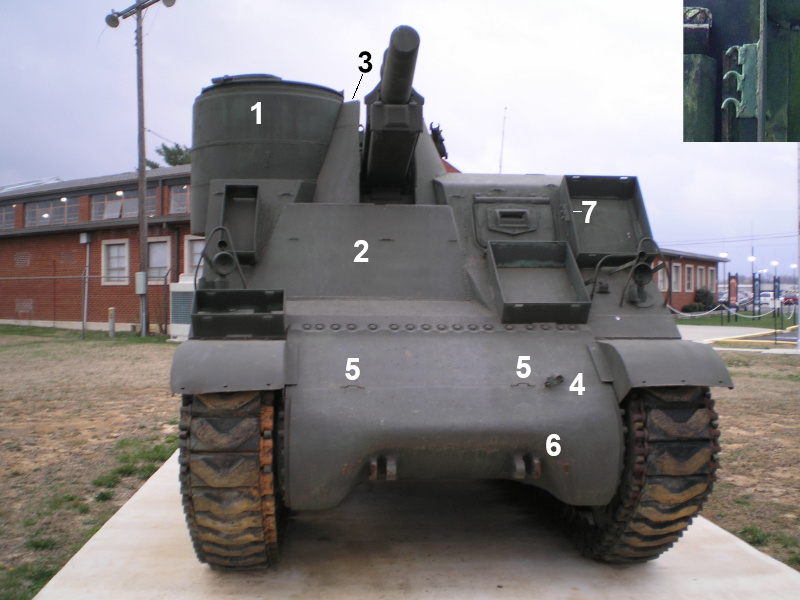
Pressed Steel Car produced a total of 826 M7B1s, which was less than a quarter of the 3314 M7s manufactured by ALCO and 176 by Federal Machine. Even so, the Ford engined Priests represent the largest number of survivors with about 34 M7B1s and 58 M7B2s recorded to date. We use "about" with the totals because almost half of the surviving M7B1s appear to be backdated M7B2s, done no doubt because restorers prefer to own or present a WW II era Priest. Ordnance Committee Item 35296 dated 6 May 1954 includes some historical reference including a request on 21 November 1952 by Army Field Forces No 1 "for the rehabilitation of the 105-mm Howitzer Motor Carriage M7B1 to include high angle fire." Rock Island Arsenal designed a pilot model "of an M7B1 incorporating, primarily, a +65 degree elevation. This was done by raising the Mount, M4A1 15 inches and depressing the floor 4 inches. Elevating arcs from the 105-mm Howitzer field piece were used [and] adequate armor shielding for the raised mount was provided." The RIA pilot was found acceptable after some modification by Army Field Forces No 1 at Ft. Bragg. "A second pilot was then produced by a commercial rebuild facility who modified the vehicle in accordance with the test and also incorporated some additional changes and refinements. Some 78 vehicles have been modified by this facility and additional vehicles will be modified in base shops." No dates are provided and the "commercial rebuild facility" is not named. Reading between the lines of the reference sections of the OCM, we would guess that RIA produced the pilot model in early 1953, and that the commercial facility produced 78 units sometime in 1953 and 1954 before 6 May 1954 when OCM 35296 designates them as "M7B2" and reports that there are 78 "units on hand." From our study of Shermans, we have found that there were two commercial facilities rebuilding AFVs in the 1950s: Bowen-McLaughlin in York, Pa. and Brown and Root in Houston, Texas. Except for "Brown and Root" dataplates on a few surviving Shermans, we have not come across any documentation about B&R. We did scan a contract card for Bowen-McLaughlin showing that they were engaged by the Government to rebuild 98 "105MM How. Carriage M7B1." The company signed the contract on 12 December 1952, and if we have read it correctly, the cost per unit was about $7500. This contract could have just been for the rebuilding of straight M7B1s, or Bowen-McLaughlin may have been requested to perform a high angle conversion before the "M7B2" nomenclature was adopted. We are not aware of any period factory photos, so here we have a front shot of the M7B2 on display at the National Guard Post in Tullahoma, Tennessee. The most obvious change is the heightening of the pulpit (1), followed by the multi-part shield (2) for the raised gun mount. Note that this shield covered over the transmission oil filler cap. The curved gun shield can be seen to have had some material (3) welded on to raise it up as well. We consider the location of the cable clamp (4) on the differential housing to be in the M7B1 "as built" configuration. On the other hand, we consider the footman loops (5) to be retrofits and would observe that these have been noted on a number of surviving Ford M4A3s that we have determined were rebuilt by Bowen-McLaughlin in the 1950s. Of course, as built, this diff would have had little strip steps (6) which are now missing on both sides. The item (7 and inset) attached to the grouser box appears to be the comb device typically seen on AFVs processed through the Lima Tank Depot in Ohio.
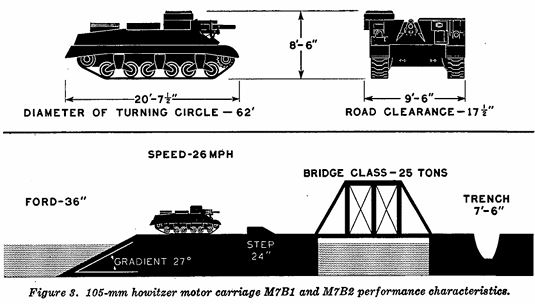
The Transportation Corps did not disagree or "non-concur" with OCM 35296 which described the military characteristics and designated the high angle conversion as "M7B2". However, they did note for the record that "this modified version of the M7B1 is both wider and higher than the reported dimensions of the M7B1" and that this would affect overseas rail and US highway movement. According to the 1944 M7 and M7B1 Technical Manuals, the pulpit protruding from the side gave these models an overall width of 113 5/16 inches. The M7B2 OCM lists the width as "Irreducible - 115-1/2 inches". We don't see how the M7B2 conversion widened the vehicle, but there it is. The height of the M7B1 is listed as 100 inches, and that is for "vehicle only" without the antiaircraft machine gun or fittings installed. We have not had the opportunity to measure an M7B2 for ourselves but can note that an M7B2 information plate, which might have been mounted below the dataplate, gives the overall width as 113 1/2 inches and the "lowest operable height" as 117 inches. We take this to be the "vehicle only" height without the AA MG mounted, and if so, would indicate that the pulpit was raised 17 inches. The plate also provides the "overall height" as 131 inches which we take to mean with AA gun installed. The drawing above from the March 1954 "FM 6-74, 105-mm Howitzer M2A1 on Motor Carriage M7B1 and M7B2" provides some of the dimensions of what is obviously an M7B1. This field manual appears to have been written for the M7B1 with reference to the M7B2 added as an afterthought. There are no photos or drawings of, or specific references to the M7B2 in this FM.

"Thanks for your service." The Tennessee National Guard’s 1175th Transportation Company is headquartered in Tullahoma. In this left rear view of their M7B2 one can see the armored exhaust deflector (1) with the rods holding it in the "up" position. With one or two exceptions, the surviving M7B2s, are seen installed with the armored deflector (or its fittings). This would lead us to think that it was a "must" modification of the M7B2 program. A new stowage box (2) is noted on almost all survivors to the extent that this strikes as a "must" mod. From what is seen on a few surviving examples, it may have held a communications wire spool (inset). The pyramid shaped objects (3) on the stowage bins were obviously "door bumpers". As best we can determine they were not factory installed on 1944 production ALCO M7s or on PSC M7B1s, but they do show up in a few photos of FMW M7s. The baskets may have been moved over or resized a little when the bumpers were added. Of course, our subject is missing the blanket baskets, but we are certain they would have been factory installed when this unit rolled off the line as an M7B1 at PSC. Since this Priest has single rear towing lugs, we would judge that it would have been produced in either January or February 1945. Earlier we mentioned that we "think" that the M7B1s were built with the later "short" trailer towing pintles, but this example is seen with the earlier "long" pintle (4). We would observe that most of the surviving M7B2s in the US have the long pintles and the armored exhaust deflectors, as if a conscious effort had been made to install the longs in conjunction with armored deflectors. The few period photos available suggest that most of the M7B2 conversions simply retained their M7B1 Registration Numbers, either in the 40152XXX range or 40172XXX range for the last 198 units. The RN of the Tullahoma can be seen as USA 40233533, which is off the M7B1 "radar screen" of Ordnance assigned RNs. So, at first, we wrote off this RN as made up which is often the case with surviving US WW II AFVs.
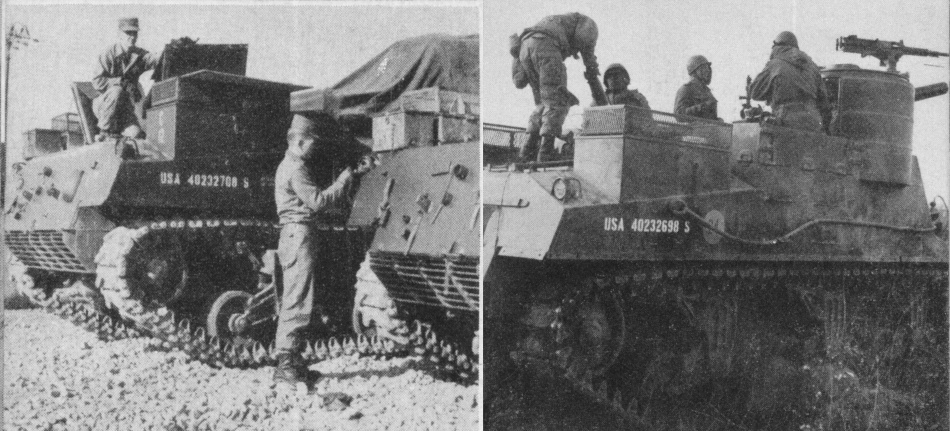
We like to record readable USA Numbers from period photos when we
see them, and the 1956 3rd Armored Division souvenir yearbook shows a
few photos of M7B2s with 40152XXX and 40172XXX Registration Numbers. In
addition, there are two photos showing USA 40232698 and 40232708 as seen
above. USA 40232708 on the left can be seen with the heavy engine deck
doors open and perhaps illustrates how the little door bumpers protected
the blanket baskets from getting smashed in. We would note that the
bumpers are present on some but not all surviving M7B2s. The photos
appear to have been taken at Ft. Knox in the winter of 1955/56. In the
Spring of 1956, the 3rd AD deployed to Germany, and it seems that their
Armored Field Artillery Battalions brought some M7B2s with them since
it is mentioned that "Sixty-three flat cars carried 100 pieces of
equipment, ranging from amphibious armored personnel carriers to
self-propelled 105mm howitzers, to Hampton Roads Army Terminal, Norfolk,
Virginia, where they were placed on vessels for overseas shipment." In
any case, we have recorded one other 40232XXX number from a photo that
was for sale online, showing USA 40232712 at APG, date unknown. So,
perhaps some M7B2 conversions were assigned new Registration Numbers? As
for "USA 40233533" on the Tullahoma M7B2, the range between the lowest
number seen in a period photo, 40232698 and 40233533 encompasses 835
units which is more than the total number of M7B1s produced. This would
lead us to think that the RN on the Tullahoma is unlikely to be
authentic.
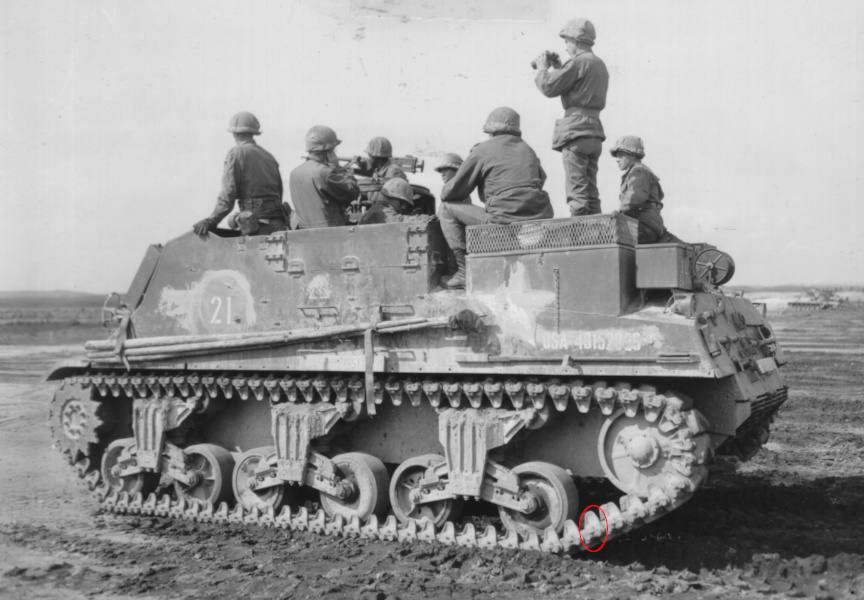
This photo is dated 7 August 1956 and captioned, "Men of the 54th AFA Bn. 3rd Armd. Div. on 105 SP. Howitzer waiting for order to fire while on the Grafenwohr [Germany], Range." There are eight gunners visible in this photo and some of them are blocking the pulpit and the gun, but we think enough of the pulpit is visible to identify this as an M7B2. There is also what we think was one of the "additional changes and refinements" added to the M7B2 - a stowage box that held a communications wire spool. On the other hand, such a spool is mounted just behind the box, perhaps for convenience, but it can be seen that the spool would fit inside the box, resting on the cradles shown in an inset in a previous caption. We recorded the Registration Number from the original print as USA 40152826, so this one retained its M7B1 RN, indicating it was accepted at PSC in December 1944. This unit can be seen with the armor plate exhaust deflector, but rather than relocate the crowbar up 3 1/2 inches to clear the deflector hinges, it has been relocated to the left rear side. This is observed in the photo of USA 40232712 at APG mentioned previously and on a few surviving M7B2s in the US such as at Camp Shelby and Starkville, Mississippi. Again we see a mix of roadwheels including a convex example at the rear. Most or all of the track end connectors appear to be the "wide guide horn" type (circled). These are thought to have been castings produced post WW II.

Here we count at least 10 M7B2s photographed at the railhead in DeRidder, Louisiana on 31 October 1955 in preparation for "Exercise Sage Brush [31 October-15 December 1955], the largest joint Army-Air Force maneuver since World War II." Ominously, the maneuver featured the use of the "atomic cannon" and "began with a simulated atomic bomb set off at Fort Polk." The caption identifies the M7B2s as belonging "to the 94th Field Artillery of the 4th Armored Division, Ft. Hood, Texas." However, the tactical markings on the foremost Priest are for the 22nd Armored Field Artillery Bn, 4th AD. Both the 94th and the 22nd, along with the 66th AFA Bn were organic to the 4th AD. As in WW II, each battalion would have been equipped with 18 self-propelled guns. "C20" can be seen with the "long" pintle (1) jutting out below the armored exhaust deflector (2). Most or all of these M7B2s are installed with armored first aid boxes (3) on the right-side stowage bins. These are present on some of the surviving M7B2s in the US. The first two M7B2s don't seem to have the little "door bumpers" protecting the blanket baskets. The M7B2 was classified as "substitute standard" with the conversion program designed to meet the Army's requirement for a 105mm self-propelled howitzer with a minimum of + 65 degrees elevation. It was intended to be used until it could be replaced by the M52 105mm Self-Propelled Howitzer (inset) in which the entire crew operated in a fully enclosed turret capable of rotation 60 degrees left or right. In mid-1955, it was anticipated, optimistically perhaps, that the M52 would "be classified as Standard type and issued to troops during the last half of calendar year 1955." Some internet sources have it that the M7B2 was used during the Korean War. We have not found any evidence that that was the case and think that M7B2s are/were being confused with M7J1s.
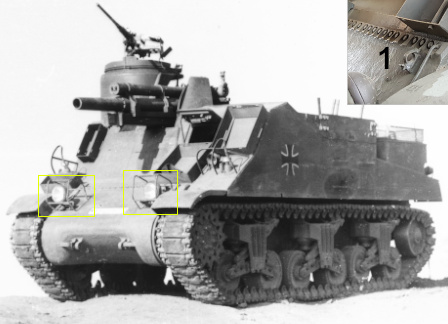
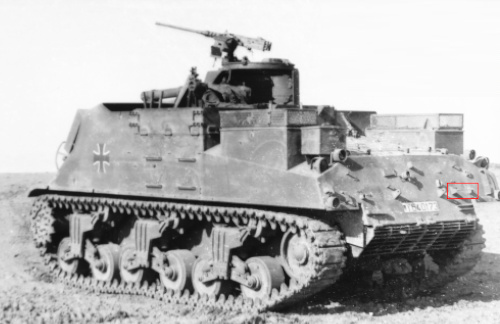
The Federal Republic of Germany (West Germany) joined NATO on 6 May 1955 during the height of the Cold War. A few months later, to the alarm and objection of many, the Bundeswehr was established. The US provided a good deal of the military equipment required to build up the nascent armed force. According to a "Status of MDAP Operations" document, Germany was allocated 162 "Carriage, Motor, 105mm How (All Models)" of which 105 had reportedly been shipped as of 31 January 1954. Of interest is that the document reports that 1229 "Tank, Medium, M46, M47, M48 series" had been allocated and shipped to Germany as of 31 January 1954. This would have been before the country joined NATO, so possibly represents the negotiation and planning process that was taking place at that time. Various internet sources have it that Germany received a number of M7B2s starting in 1956 and used them until 1966, when they were replaced by M52 105mm Self-Propelled Howitzers and M109G SPHs. The "conventional wisdom" on the internet appears to be that a total of 127 M7B1s were converted to M7B2s. This seems a bit low to us, but the only figure we can document comes from Ordnance Committee Item 35296 dated 6 May 1954, where it is stated that "Some 78 vehicles have been modified by this facility and additional vehicles will be modified in base shops." Some internet sources state that Germany alone received 127 M7B2s. Be that as it may, the largest number of surviving M7B2s appear to be former Bundeswehr vehicles. They are noted to have been retrofitted with a pair of large headlights with brush guards on the transmission housing (outlined in yellow). The electrical cable for the lights came out of the outermost bolt holes for the transmission housing and then the cables went down to small plates located underneath the headlights. The left-side light was right where the cable clamp would be located on a regular M7B1/B2, so the cable clamp (1) was moved up the transmission housing to just below the grouser box. The rear view shows a few other retrofitted items. The brackets outlined in red held an interesting addition. The illustration photos are undated and come from the Hunnicutt collection. It is thought that these modifications were made starting in the early 1960s. Readers might be interested in "Panzerhaubitze 105 mm M7B2 Priest", a Bundeswehr training film dated 1957. Four M7B2s are seen in the footage and in this case, they look to be nearly as built, without the retrofitted lights and reflectors. We wouldn't be surprised if these were the only Priests in service at that time. In 1957, the total number of soldiers in the Bundeswehr appears to have been about 10,000.
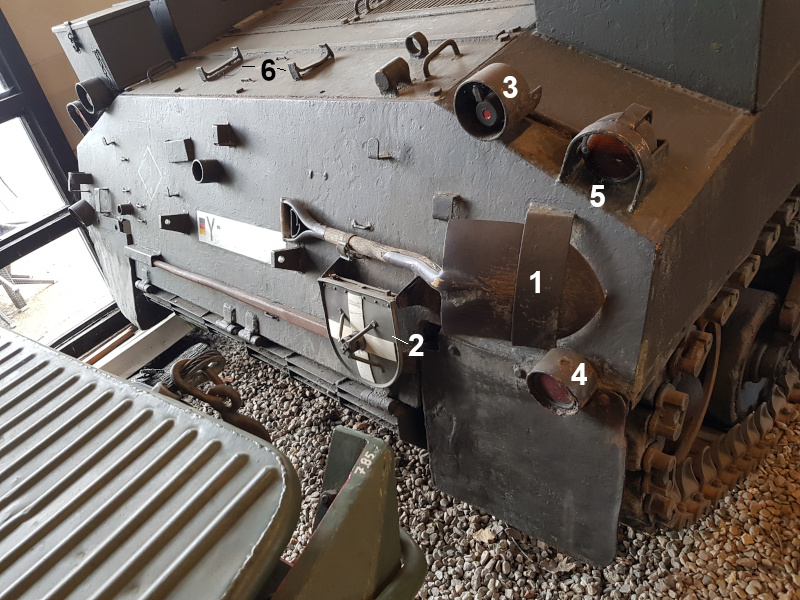
Here we have a photo of the upper rear hull plate of a Bundeswehr M7B2 on display at the Panzermuseum in Munster, Germany. It can be seen that the shovel (1) was relocated outboard from its M7B1 factory position. This new location is seen on most but not all surviving M7B2s, both in the US and abroad. It is also on a few surviving M7B1s in the States, so we would guess it was a modification done post war in the US. Item 2 strikes us as distinctly German. It is the Bundeswehr "Leitkreuz", a convoy fixture which has a light in the middle that reflects off the white cross. It serves as a point of reference for trailing vehicles during black-out driving at night. This is probably the only surviving M7B2 that still has this object intact. The Leitkreuz appears to have been installed on Bundeswehr vehicles starting sometime in the 1960s. We are told that items 3 were "blackout stop lights", and items 4 were "reflectors". The standard factory taillights (5) appear to have been replaced on this example. Counting heads suggest that the fittings numbered 6 were installed as part of the M7B2 conversion, and we are informed that they were intended to hold a machine gun tripod. Indeed, the fittings are similar if not the same as the tripod fittings seen on the left front of the hull on many Grant and Lee Medium Tanks. With thanks to Michel Van Loon.
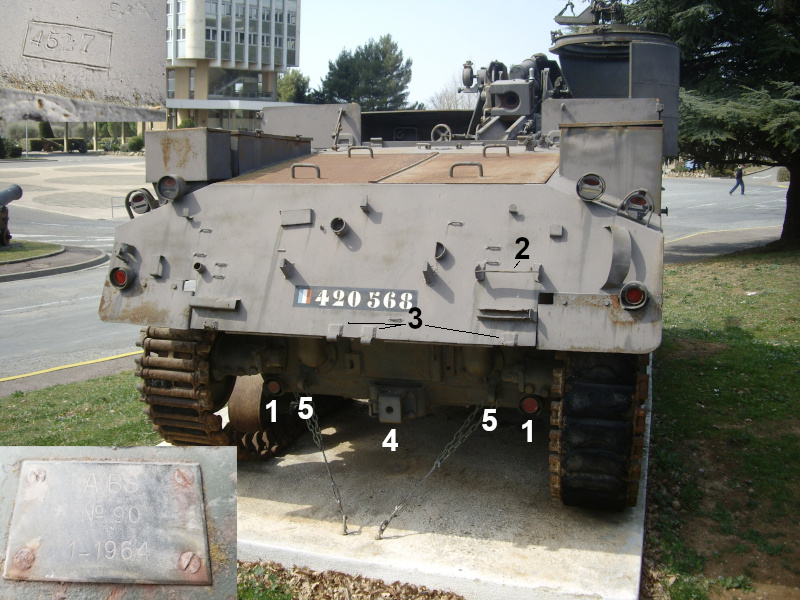
This
photo shows the rear of the M7B2 on display on the grounds of the
School of Artillery and Museum in Draguignan in southeastern
France. A pair of what we take to be reflectors (1) can be seen installed on
the lower rear hull, along with the additional lights and reflectors on
the upper hull. We think that fitting 2 would have held the Leitkreuz.
The hinges (3) indicate that this M7B2 was once installed with the
armored exhaust deflector. The fitting for the towing pintle (4) can be
seen in what we have previously described as the "two tiered" mounting
configuration, thought to have been intended to locate the short pintle
further out from the hull when the armored exhaust deflector was
installed. This Priest is noted with a French 1942 era "matricule"
number and is named "La Nartelle". Earlier in the piece we mentioned that Maréchal des Logis Joseph
Gonzales stated that the 68ème Régiment d'Artillerie d'Afrique, 1er
Groupe landed at 8:00 am on 16 August at La Nartelle Beach. Perhaps the 68ème RAA named one of their WW
II M7 Priests in commemoration of that moment? We have
assumed that the additional fittings were German modifications, because
a number of surviving M7B2s with them have been seen with traces of the
"Eisernes Kreuz" under the paint layers before restoration. This was,
of course, the insignia adopted by the Bundeswehr. However, according
to a "Status of MDAP Operations", France was allocated 140 "Carriage,
Motor, 105mm How (All Models)" of which 109 had reportedly been shipped
as of 31 January 1954. Furthermore, most of the surviving M7B2s in
Europe have little plates attached to the front indicating that they
were rebuilt by ABS (Atelier de construction de Bourges) in France
(inset). The surviving tags have dates from 1961 through 1964. So, one
might get the impression that these were French M7B2s. Our preferred
theory is that the Germans contracted with ABS to rebuild a number of
their M7B2s. If any readers can shed light on this subject, we would be pleased to have your report. One of the happy consequences of the ABS
rebuild program from a research standpoint is that the serial numbers
of the various Shermans and Priests, etc. were stamped on the fronts of
the vehicles. So, for example, this M7B2 is stamped with "4527" (inset)
indicating that it was built by PSC in January 1945 and was about the
75th out of 150 M7B1s produced that month. As far as we can determine,
PSC did not stamp the SN on the exterior of any of the AFVs it built,
so the "SN in a box" is a great help. Comparing SN 4527 with the
stampings recorded from other surviving examples would lead us to
conclude that 4527 would be about "ground zero" for the change from
double to single rear tow lugs (5).
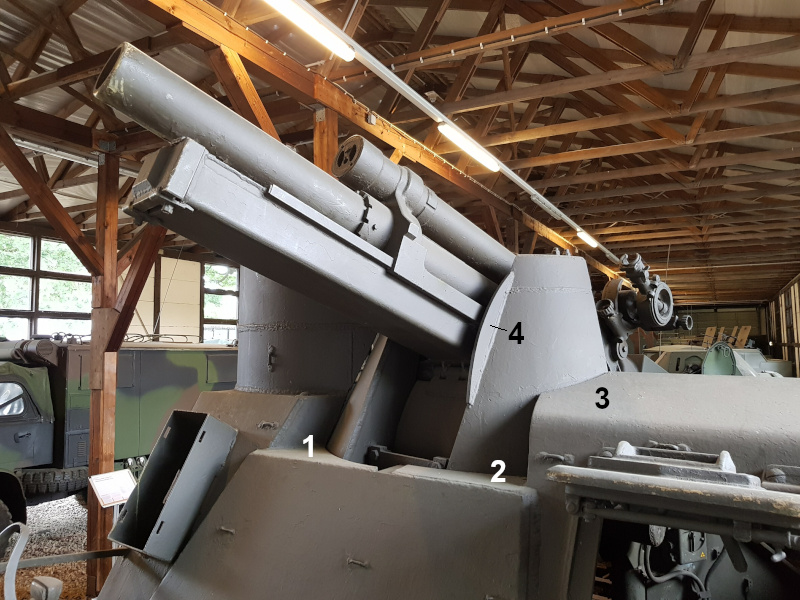
Earlier we mentioned "the multi-part shield for the raised gun mount." Pierre-Olivier was able to get a photo of the Panzermuseum M7B2 showing the pieces (1 and 2) added to the top of the shield and cut to follow the contours of the curved gun shield. The "awning" (3) of the original design was also cut to follow the contour. Note the curved plate (4) added to the gun shield. This is observed on all of the surviving M7B2s.
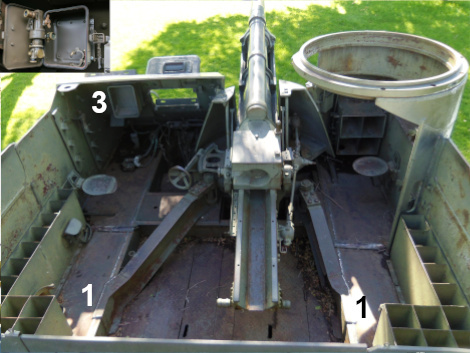
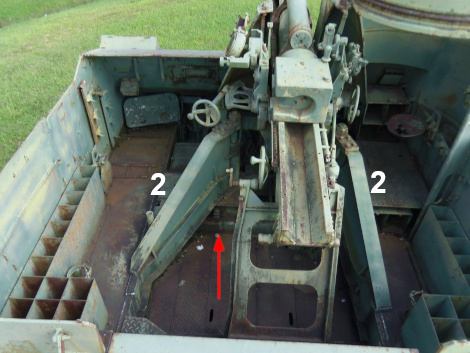
Ordnance Committee Item 35296 dated 6 May 1954 provides a brief description of the M7B2 conversion process which states that the gun mount was raised 15 inches, and the floor was depressed 4 inches. The photo on the left shows the fighting compartment of the M7B1 on display in Missoula, Montana. Note the way the trails (1) were welded to the sponson sides. This was the standard configuration used on M7s and M7B1s. The photo on the right is of the M7B2 in Tullahoma, Tennessee and shows how "spacers" (2) were welded on to the tops of the original trails which raised the gun by 15 inches. The heightened gun travel lock appears to have been fashioned by inserting and welding in a section from another gun travel lock right in the middle. The depression of the floor by 4 inches is a bit subtle, but the drop can be seen below the I-beam as indicated by the arrow. The vertical ammunition containers look to be unchanged on the M7B2. The depression of the floor by 4 inches doesn't seem to have greatly affected the number of rounds carried. In the military characteristics section, OCM 35296 lists the ammunition capacity of the M7B2 as "68 rounds". This is but one less than the 69 rounds given in the August 1944 M7 Technical Manual. Oddly, we could not find a listing of the 105mm ammunition capacity in the August 1944 M7B1 Technical Manual. Quite a few surviving Priests are missing the box (3) just to the left of the driver's door. The inset shows that this served to protect the Panoramic Sight from water and other types of damage when not in use.

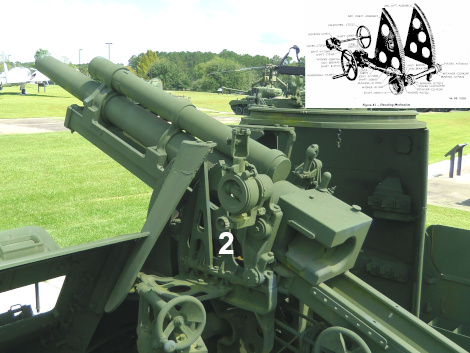
A description in OCM 35296 suggests that the M7B2 conversion required a bit of cannibalization: "Elevating arcs from the 105-MM Howitzer field piece were used..." The photo on the left shows the left side elevating arc (1) as seen on the M7B1 in Helena, Montana. The photo on the right shows the much higher elevating arc (2) required for the M7B2 as seen on the example on display at Camp Shelby, Mississippi. The inset drawing is from the M2/M2A1 Howitzer Tech Manual and shows what we believe were the arcs that were used for the M7B2 conversion.

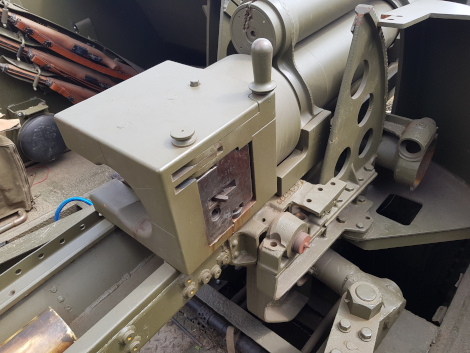
We would note that a number of the "M7B2 back to M7B1" conversions are seen to have retained the higher elevating arcs. The photos above show a pair of backdated M7B1s and provide a good view of the higher arcs, which are characterized by 4 holes, assumed to be lightening holes intended to reduce the weight of the component.
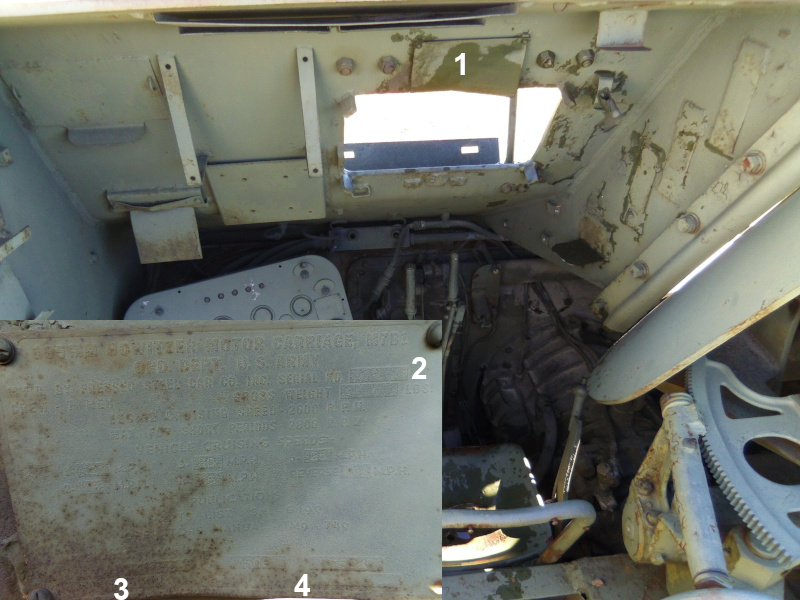
The M7 Technical Manual refers to the "Identification and Speed Data Plate." The plate lists the maximum speeds in the five forward gears and one reverse and advises that "The engine is equipped with a governor to limit the road speed in all gears, as shown on the plate on the front hull wall. CAUTION: Do not permit the vehicle to exceed these speeds when driving downgrade, to avoid damage to power train and engine." It has been noted that some mechanically inclined crew members disabled the governors on their AFVs. The main photo shows the standard location of what has come to be called the "dataplate" (1) in US WW II "tank circles". The dataplates are mostly missing from surviving M7 series, but Pierre-Olivier noticed this on one of the two M7B1s in Helena, Montana and took a few photos. It can be seen that the Priest is identified as an M7B1, manufactured by "Pressed Steel Car Co. Inc." Unfortunately, the "Serial No." stamping (2) is not readable. Judging by a few PSC Sherman dataplates, the year of manufacture should be stamped into the box (3) at the lower left. We have seen the surname "GRUHLKE" stamped into the box (4) at the lower right on a couple PSC Shermans. (Leonard Gruhlke was the head of the Inspection Department at PSC.) Sorry to say, none of that is readable in this case. The "Vehicle Cruising Speeds" are readable as 2 MPH in first gear, 6 in second, 10 in third, 16 in fourth, 25 in fifth and 3 MPH in reverse. (These speeds are about 1 MPH more than those seen stamped on ALCO M7 dataplates.) This M7B1 has "USA 40152523" painted on the sides and rear. This is a valid M7B1 Registration Number corresponding to Serial Number 4060, built in August 1944. However, the other M7B1 in Helena has the same RN painted on, which throws the whole thing in doubt. Unfortunately, PSC and Federal Machine and Welder did not stamp the Serial Number on the rear towing lugs (or anywhere else on the exterior as best we can determine) of their M7s and M7B1s, so the SN on the dataplate or the French ABS stamping on the front is the best shot we have of getting a Serial Number from these models.
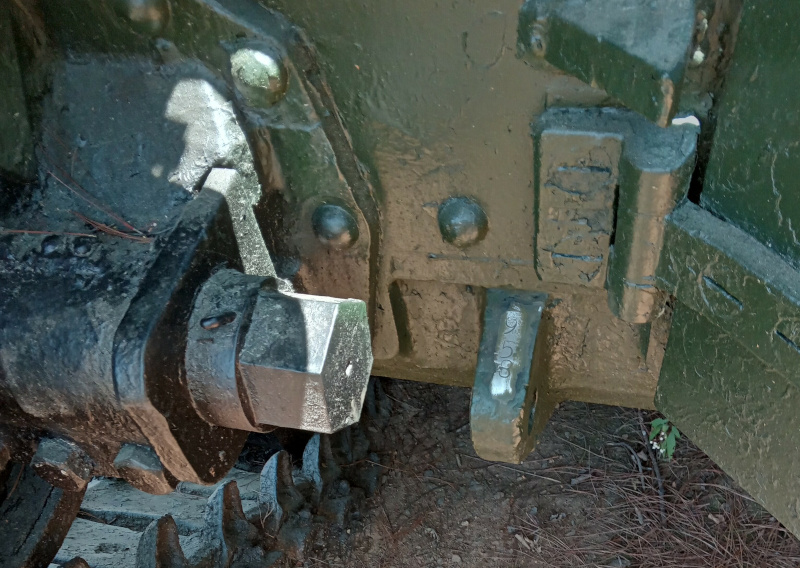
Earlier, we showed the dataplate of the ALCO M7 that went down with its LCT on D-Day and was recovered and is now on display at the museum in Port en Bessin. The examination of a few surviving examples suggests that ALCO stamped the Serial Number on the left rear towing lug (only) of the M7s it manufactured. The photo is of the stamping as seen on the M7 SN 958 that Jim Goetz examined at the Philippine Military Academy in Baguio, Luzon. At present, we think there are about 30 surviving ALCO M7s in the world and we have been able to record the SNs of around half of them. Pakistan appears to have what we take to be a former M7J1 on display at Ayub National Park in Rawalpindi. A description with the photo states that "Pakistan received 150 units in 1955 under the MAP program which went on to serve the army throughout the cold war." Should any readers have occasion to see this Priest, we would be happy to have your report.
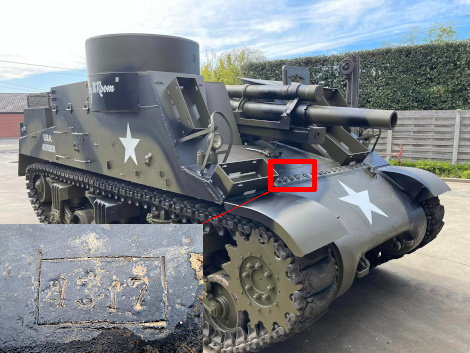
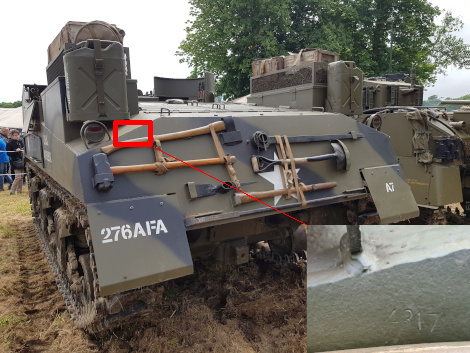
Pressed Steel Car does not appear to have stamped the serial numbers anywhere on the exterior of the M7B1s they produced. However, some surviving ex-German M7B2s have been observed with the serial number stamped on the front and rear of the hull as shown on these photos of SN 4317.
PAGE 3/3
Go to page 1 Go to page 2